An Interview with Gowthama Sannah, Propaganda Secretary of the Viduthalai Chiruthaikal Katchi (VCK), by Prof.Dr. Hugo Gorringe – University of Edinburgh, United Kingdom, Hugo.Gorringe@ed.ac.uk
————————————————————-
Published by ASIANIST, Edinburg, Uinted Kingdom
————————————————————-
The compromised and ‘failing’ position of the Bahujan Samaj Party (BSP) and Republican Party of India, led one eminent commentator to urge Dalit activists and scholars to “look south because Tamil Nadu may offer some important lessons” for Dalit politics (Omvedt 2003: xvii-xviii). Tamil Nadu is indeed an interesting case study because it is one of the more developed states within India and has a long history of anti-caste politics and legislation. Despite this, it remains one of the more caste-divided regions as well. Autonomous mobilisation by Dalit groups coincided with an increase in casteist violence designed to keep the Dalits in a subordinate position (Gorringe 2006). It is only in the past decade, therefore, that Dalit parties have achieved sufficient credibility to forge alliances with established parties (Wyatt 2009). No Dalit party has been able to emulate the success of the BSP in electoral terms, but the political context here is very different (Omvedt 2003). The primary aim of Dalit parties in Tamil Nadu, rather, has been to strip ‘Dalit voters away from Dravidian parties’ (Roberts 2010: 18). Omvedt’s opinion comes in a book of speeches by the Tamil Dalit leader Thirumavalavan and she argues that the passion and vibrancy that characterised initial BSP mobilisation are captured in the fiery speeches and grass-roots mobilisation of Thirumavalavan and the Viduthalai Ciruthaigal Katchi (VCK – Liberation Panther Party) – the largest Dalit movement in Tamil Nadu. Roberts (2010) concurs with Omvedt’s assessment and argues that the Tamil Dalit movement has a wider social and political significance that extends beyond the state. In the past few years the VCK have cemented their alliance with the Dravida Munnetra Kazhagham (Dravidian Progressive Federation – DMK), one of the two main political parties in the state, and have gained entry to the political mainstream. On one hand, commentators suggest that the VCK offer a different, Dalit, way of doing politics rather than mimicking the established parties and point to welfare concessions that they have secured since allying with the DMK.
Conversely, there is a widespread sense that the VCK are in danger of emulating other institutionalised movements by losing their radicalism and alienating their supporters. There are widespread allegations of corruption and profiteering, including numerous stories of VCK activists acting as brokers or middlemen in caste disputes for monetary gain. This interview was conducted as part of a research project, focused primarily on Dalit voters and activists in and around Madurai in order to understand how political subjectivities, ideas of citizenship, and perceptions of social exclusion have been reshaped by the entry of autonomous Dalit parties into the political mainstream. It is trying to understand whether and/or how the demands and critiques of Dalit movements have been integrated into the political behaviour of Dalit citizens and also the extent to which such ideas have informed the wider political sphere. Whilst interviews with Thirumavalavan frequently feature in Tamil magazines, it is much less common for those in secondary leadership positions to be able to articulate their positions. This interview with one of the leading Dalit intellectuals in the party offers a frank and reflexive account of the trials and tribulations of Dalit politics in Tamil Nadu.
This interview had been taken at Chennai on 26th Sep 2012
———————————————————————————————————–
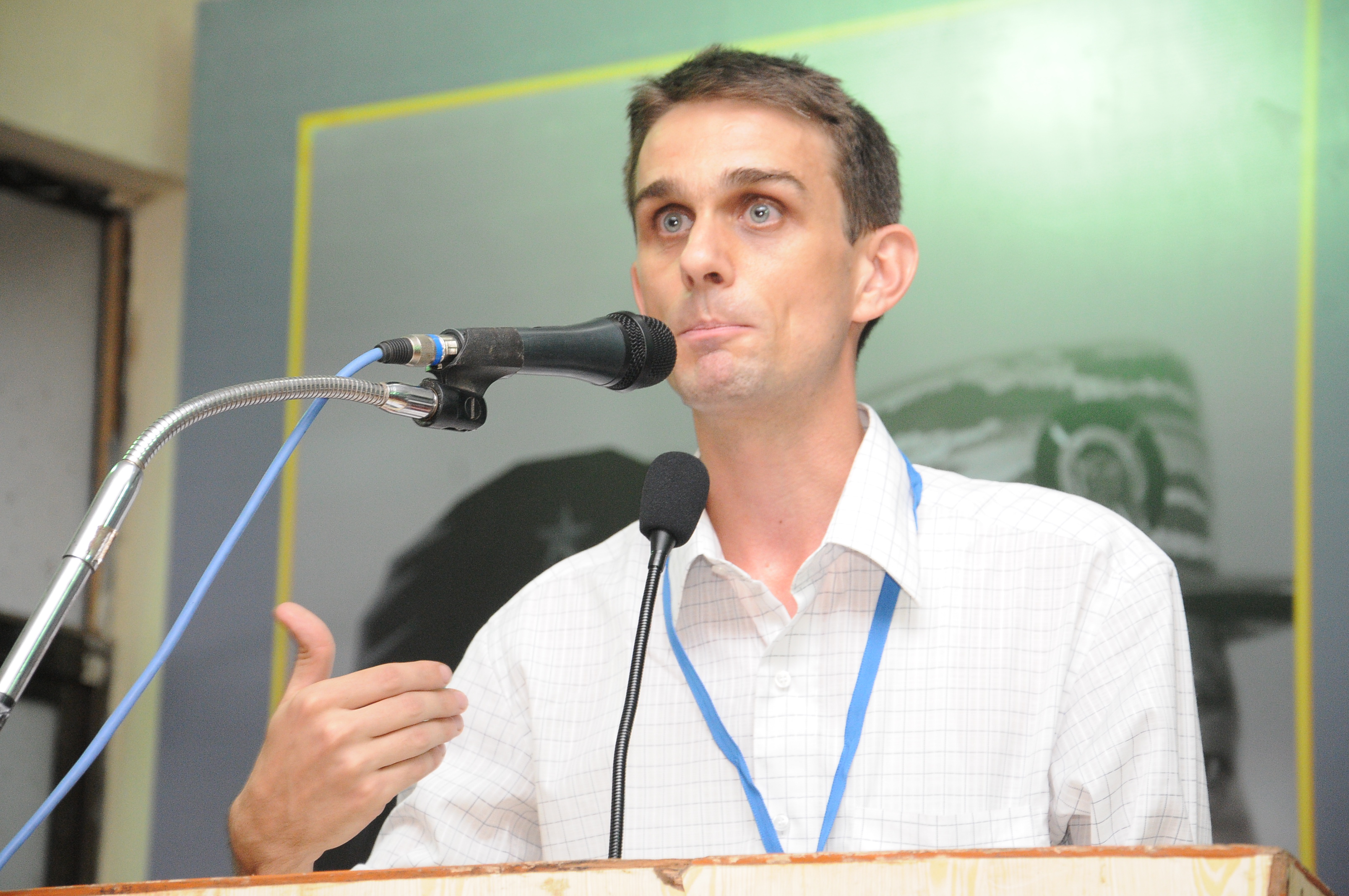 Dr. Hugo Gorringe, Sociology Department, Edinburgh University (UK), conducted research on Dalit Movements in 1999 when the Dalit Panthers of India (now renamed Viduthalai Chiruthaigal Katchi – or Party – VCK) was the largest and most vibrant movement in the state of Tamil Nadu, South India
Dr. Hugo Gorringe, Sociology Department, Edinburgh University (UK), conducted research on Dalit Movements in 1999 when the Dalit Panthers of India (now renamed Viduthalai Chiruthaigal Katchi – or Party – VCK) was the largest and most vibrant movement in the state of Tamil Nadu, South India
———————————————————————————————————–
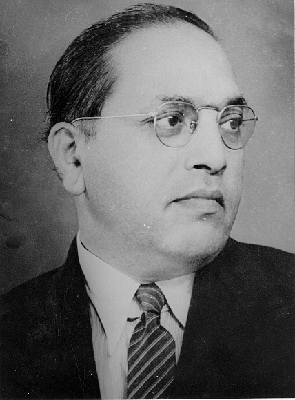 Hugo: What is the current situation of Dalits? Not just that. As discussed before, this is Dravidian Land. Politicians here have spoken about caste eradication since Periyar. Are Dalit movements really necessary in this land?
Hugo: What is the current situation of Dalits? Not just that. As discussed before, this is Dravidian Land. Politicians here have spoken about caste eradication since Periyar. Are Dalit movements really necessary in this land?
Sannah: Not just in this state, across India there is a pressing need for Dalit movements. If you ask why, even though there is oneviewpoint that casts this as the land of Periyar EVR– like you said – as far as Dalits are concerned their mobilisational history stretchesback more than 150 years. In 1777 in Chennaithere was a major protest which RettaimalarSrinivasan has written about in his autobiography.There was an inquiry held inChennai’s St George Fort concerning a Dalitmurder, and there was a serious riot at that point. Linked to that conflict there was a rise in Dalit consciousness and mobilisation. Since then there has been continuous struggle, but there was a lack of organisation at that time that hindered the opportunity for greater change. If you ask when that happened, in 1840 the term Adi-Dravidar was introduced as a sociopolitical name meaning ‘original’ or ‘indigenous’ Dravidian. Subsequently, in 1880 the Adi-Dravidar Mahajana Sabhai (Adi- Dravidar People’s Organisation) was formed as a structured movement, followed by the Paraiyar Mahajana Sabhai (People’s Organisation of Paraiyars) in 1890, and the Dravida Mahajana Sabhai (People’s Organisation of Dravidians) in 1891. That means three very significant movements started operating between 1880 and 1891. All Dalit movements today may be seen as offspring of these organisations. The ideals they articulated and the demands they lay down are precisely the ones that are being followed today. The leaders like Periyar EVR and others who you mentioned are merely leaders who have come and gone in the interim. Apart from 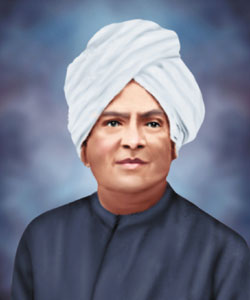 Periyar EVR we need to mention many names: Between 1845 and 1880 there was a galaxy of leaders who laboured for the Dalit people. Figures like V. Ayothidas Pandithar (who was K. Ayothidas Pandit’s teacher), the poet Vairakkan Velayudham, Venkitasamy Pandithaar, Arankayyadass Pandithar, Mylia Chinna Thambi, Poet P.A.A. Rajendram Pillai (who was also a noted novelist), and Saangu Siddha Sivalinga Nayanar. These leaders paved the path to future Dalit politics by socializing the Dalit masses. Some efforts to mobilise the people also occurred in this period including the Subhichara Sangam (Welfare Association), Poorva Tamil Abimaana Sanga (Original Tamil’s Welfare Association), Panchamar Kalvi Sangam (Untouchable’s Educational Association), and Adhular Abiviruthi Sangam (Dalit Welfare Association). The work of these luminaries prepared the ground for the emergence of subsequent leaders who carried their wishes and aims forward in the socio-political arena. Key figures here include K. Ayothidass Pandithar (or Ayothidasar as he is known in Tamil) – who was the first social reformer in south India who started the Casteless Dravidian People’s Movement – and his friend D. John Ratnam who founded the Dravidar Kazhagam and Dravidar Pandian Magazine in 1887, well before EV Ramasamy Naicker launched his Dravida Kazhagam. Other leaders of this period were B.M. Madhura Pillai, B.Venkatachala Subramanyam, Mylai Chinnathambi, Swamy Arankaiyya Dassar (Editor of the 3rd Dalit magazine – Sugirtha Vasani (Good Words)) O. Palanisamy, OmPrakasa Swamy, V.C.Vasudeva Pillai, Swamy Desikanantha, M.C.Madhura Pillai, V.Darmalingam Pillai, all represented the Adi Dravidar Mahajana Sabha and L.C. Gurusamy and H.M. Jeganathan represented Arunthathiyars in said movement. In early period of 1910s K. Appadurai, Poet Periyasamy, R. Veeryan were prominent, and from 1920s M.C. Raja emerged as the first national Dalit leader of All India Depressed Class Federation. Subsequently, from the 1930s Swamy Sagajanandar, P.M. Velayudhapani, V.I. Munusamy Pillai, N. Sivaraj, Annai Meenambal (the first Dalit Women Leader in India), Jothi Venkita Chellam, and B. Parameswaran also campaigned for Dalits political rights influenced by Dr.Ambekar. There is, thus, a very long and rich history of Dalit mobilisation in Tamil Nadu. Over and above all these Pandit Ayothidasar had an ideological basis in his attempts to mobilise people. He saw only those without caste as
Periyar EVR we need to mention many names: Between 1845 and 1880 there was a galaxy of leaders who laboured for the Dalit people. Figures like V. Ayothidas Pandithar (who was K. Ayothidas Pandit’s teacher), the poet Vairakkan Velayudham, Venkitasamy Pandithaar, Arankayyadass Pandithar, Mylia Chinna Thambi, Poet P.A.A. Rajendram Pillai (who was also a noted novelist), and Saangu Siddha Sivalinga Nayanar. These leaders paved the path to future Dalit politics by socializing the Dalit masses. Some efforts to mobilise the people also occurred in this period including the Subhichara Sangam (Welfare Association), Poorva Tamil Abimaana Sanga (Original Tamil’s Welfare Association), Panchamar Kalvi Sangam (Untouchable’s Educational Association), and Adhular Abiviruthi Sangam (Dalit Welfare Association). The work of these luminaries prepared the ground for the emergence of subsequent leaders who carried their wishes and aims forward in the socio-political arena. Key figures here include K. Ayothidass Pandithar (or Ayothidasar as he is known in Tamil) – who was the first social reformer in south India who started the Casteless Dravidian People’s Movement – and his friend D. John Ratnam who founded the Dravidar Kazhagam and Dravidar Pandian Magazine in 1887, well before EV Ramasamy Naicker launched his Dravida Kazhagam. Other leaders of this period were B.M. Madhura Pillai, B.Venkatachala Subramanyam, Mylai Chinnathambi, Swamy Arankaiyya Dassar (Editor of the 3rd Dalit magazine – Sugirtha Vasani (Good Words)) O. Palanisamy, OmPrakasa Swamy, V.C.Vasudeva Pillai, Swamy Desikanantha, M.C.Madhura Pillai, V.Darmalingam Pillai, all represented the Adi Dravidar Mahajana Sabha and L.C. Gurusamy and H.M. Jeganathan represented Arunthathiyars in said movement. In early period of 1910s K. Appadurai, Poet Periyasamy, R. Veeryan were prominent, and from 1920s M.C. Raja emerged as the first national Dalit leader of All India Depressed Class Federation. Subsequently, from the 1930s Swamy Sagajanandar, P.M. Velayudhapani, V.I. Munusamy Pillai, N. Sivaraj, Annai Meenambal (the first Dalit Women Leader in India), Jothi Venkita Chellam, and B. Parameswaran also campaigned for Dalits political rights influenced by Dr.Ambekar. There is, thus, a very long and rich history of Dalit mobilisation in Tamil Nadu. Over and above all these Pandit Ayothidasar had an ideological basis in his attempts to mobilise people. He saw only those without caste as 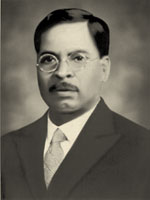 Tamils, and only those without caste as Dravidians. Those who accepted caste were not Tamils or Dravidians, only those who rejected caste were identified as Tamils or Dravidians. He split society into two camps; not just Dalits and non-Dalits since those non- Dalits who rejected caste could also claim to be Tamil or Dravidian. He founded a mass movement around this central concept. This was the forerunner of the Self-Respect Movement in South India. So, not just in Tamil Nadu, what Dalit movements require is to focus on people’s rights. The demands rose in the 1880s – Ayothidasar led a petition in 1891 – the demands raised there have not yet been realised for Dalit people and remain as important today as they were then. Consequently, Dalit movements are absolutely essential for Dalit people today.
Tamils, and only those without caste as Dravidians. Those who accepted caste were not Tamils or Dravidians, only those who rejected caste were identified as Tamils or Dravidians. He split society into two camps; not just Dalits and non-Dalits since those non- Dalits who rejected caste could also claim to be Tamil or Dravidian. He founded a mass movement around this central concept. This was the forerunner of the Self-Respect Movement in South India. So, not just in Tamil Nadu, what Dalit movements require is to focus on people’s rights. The demands rose in the 1880s – Ayothidasar led a petition in 1891 – the demands raised there have not yet been realised for Dalit people and remain as important today as they were then. Consequently, Dalit movements are absolutely essential for Dalit people today.
Hugo: Now, have the movements that came in-between, the Periyarist movements, obscured the history of these early movements? We tend not to talk about Ayothidasar or other leaders but focus on Periyar. Wherever you look there are Periyar/EVR statues and pictures and only rarely do you encounter Pandit Ayothidasar and Rettaimalar Srinivasan.
Sannah: Yes.
Hugo: Have we forgotten the earlier leaders due to the emergence of the Dravidian Federation?
Sannah: We can split this into what the benefits and disadvantages of the Dravidian Movements have been. This is something that we have to address in some detail. If you ask why, then everyone says that the Dravidian movements started in 1917. In 1912, all the high caste traders and landlords in Chennai joined hands to form a movement which they called the South India Traders’ Association which soon became the South India Welfare Association in 1916. This then became the Justice Party. This is the background to the emergence of the party. If you ask what their motives at the outset were, then it was clearly not their objective to attain liberation for the Dalit people, nor did they ever sign up to that goal. Even in the first Justice Party manifesto there is nothing more than a statement to the effect that basic needs of the downtrodden should be addressed, there is nothing about rights here at all. So if you ask what their main objective was; Brahmins had allied with the whites (British Indian Government Authorities) to gain a share of official authority. It was to claim a share of that power that this movement was formed: The Non-Brahmin Movement. They wanted a share of power and to claim that share they needed some basis for their claim. They argued that they had been denied a share of power that was due to them and used arguments of social justice to demand power for them. It is because they mobilised on this basis that the identity of the Justice Party was created. We cannot, however, expect them to raise up the Dalit people below them given the basis on which they operated. Had they had any interest in social justice more generally they would not have defeated the temple entry bill brought forward in 1921, but they are the ones who defeated it. They stood together in opposition to that bill and ensured that it lost. It was only later under sustained pressure from Rettaimalai Srinivasan, M.C. Raja and others that they finally enacted the legislation. Important work that they did after did involve the Labour Commission which pressed for the creation of a fund for the education of the downtrodden. As soon as this lot came to power this was one of the first funds that they cut. They kept depleting it and depleting it until the opportunities for the downtrodden to study were dramatically diminished. We can see that they split society into three categories: Brahmin, non-Brahmin and Dalit. Those who suffered most from this division at the time and who continue to suffer are the downtrodden. The notion that the Periyarist movement achieved anything significant for the downtrodden is simply an illusion. Beyond that, after Periyar entered the Dravidian movement he created the Self-Respect Movement and he sought to unite the downtrodden people. Even though he succeeded in rallying them to some extent he remained true to the old model of society. He could not go beyond it because there were many downtrodden leaders at the time which was a major obstacle to them accepting him as a leader. Since the Dravidian movement was mainly 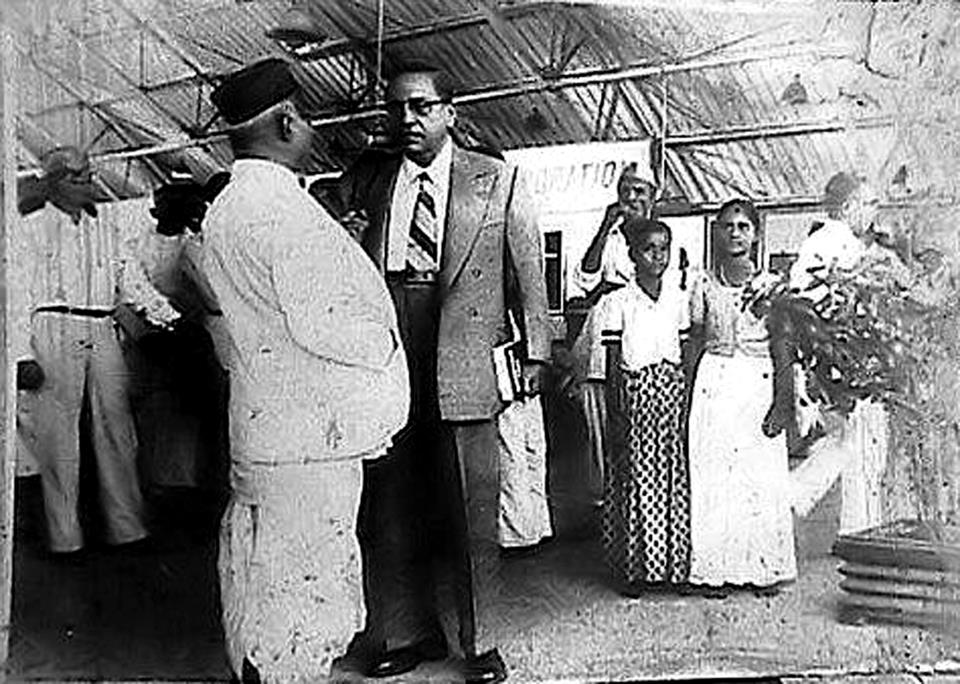 made up of non-Dalits, there was a social obstacle to the inclusion of the downtrodden as well. No matter what they may have desired, there was this social bar to overcoming the gap between the downtrodden and others. Then, the Dravidian movement emerged as a potent political force: in 1939 you have the Dravidian Federation and in 1949 you have the foundation of the DMK. In those 10 years when they were heading into politics and establishing themselves, they felt that they would be able to gain power only if they mobilised on the basis of a Dravidian identity and they began, even at this stage, to mask aspects of downtrodden identity. They did not need them. The downtrodden needed to turn their identity into a vote-bank or there was no need to unite with them. So the whole direction of the non-Brahmin movement clashed headlong with and suppressed Dalit identity; nowhere did they significantly endorse or support the downtrodden at all in any of the organs of the Justice Party or the Dravidian Parties or even the Republican Party. More specifically I have read a piece about Ambedkar in a magazine called Kaandibam that argued that he was a northern leader and asking why we were bringing him down South that is how they began to speak. In this manner they even started to obscure Ambedkar at this point in time. Although Periyar may not have had this aim, the Dravidian movement has been unable to escape the shackles of caste. So the Dravidian movement knowingly or unknowingly has a huge role in suppressing the history of Dalit politics and the other aspects of social history.
made up of non-Dalits, there was a social obstacle to the inclusion of the downtrodden as well. No matter what they may have desired, there was this social bar to overcoming the gap between the downtrodden and others. Then, the Dravidian movement emerged as a potent political force: in 1939 you have the Dravidian Federation and in 1949 you have the foundation of the DMK. In those 10 years when they were heading into politics and establishing themselves, they felt that they would be able to gain power only if they mobilised on the basis of a Dravidian identity and they began, even at this stage, to mask aspects of downtrodden identity. They did not need them. The downtrodden needed to turn their identity into a vote-bank or there was no need to unite with them. So the whole direction of the non-Brahmin movement clashed headlong with and suppressed Dalit identity; nowhere did they significantly endorse or support the downtrodden at all in any of the organs of the Justice Party or the Dravidian Parties or even the Republican Party. More specifically I have read a piece about Ambedkar in a magazine called Kaandibam that argued that he was a northern leader and asking why we were bringing him down South that is how they began to speak. In this manner they even started to obscure Ambedkar at this point in time. Although Periyar may not have had this aim, the Dravidian movement has been unable to escape the shackles of caste. So the Dravidian movement knowingly or unknowingly has a huge role in suppressing the history of Dalit politics and the other aspects of social history.
Hugo: Two questions arise out of this. You mentioned two issues: firstly, at the very outset, Ayothidasar campaigned for Tamil rights and liberty without foregrounding caste
Sannah: Not Tamil rights, he used Tamil identity to protest for the rights of the oppressed people and sought to gain their liberation in this manner.
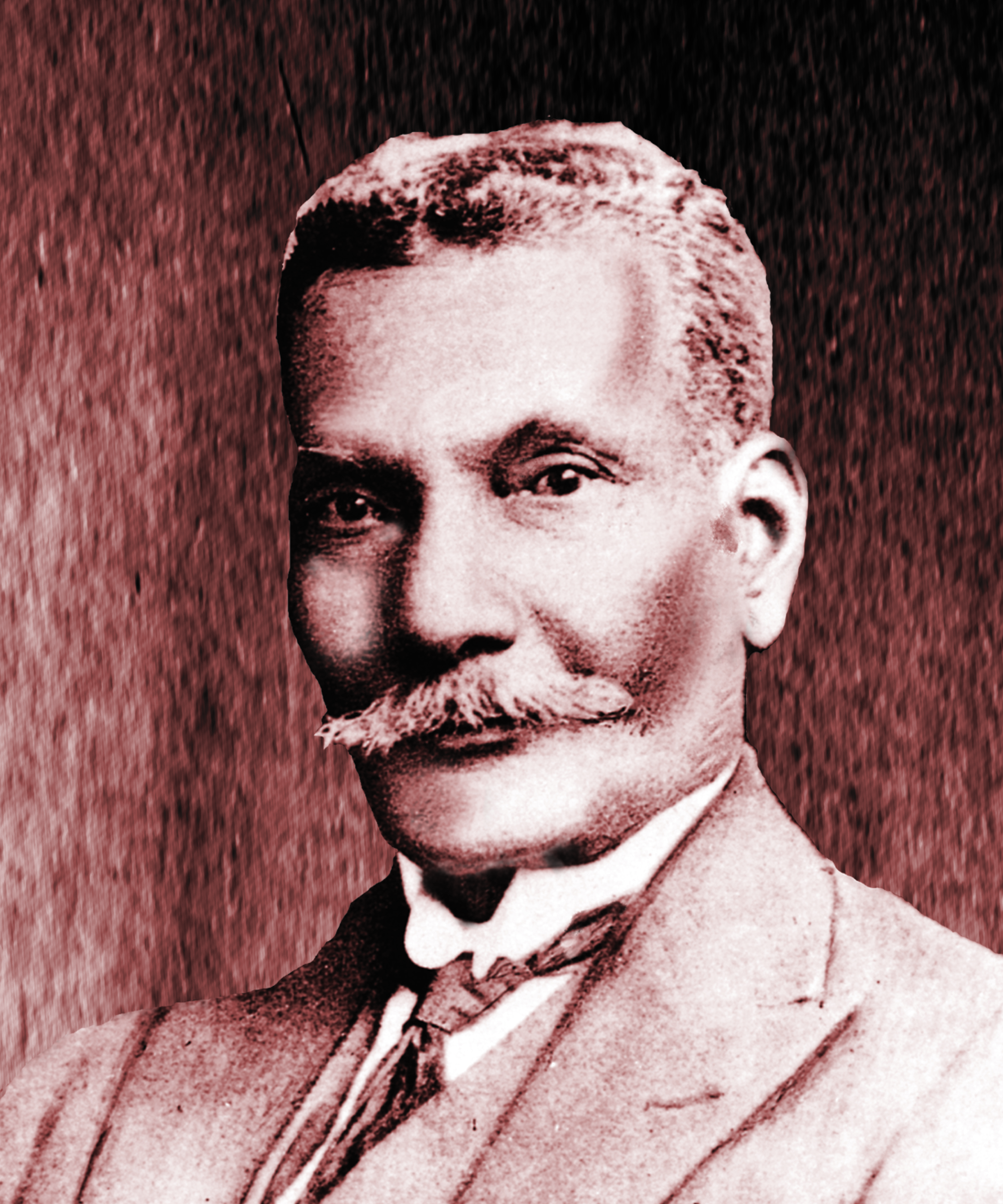 Hugo: Okay. At the same time Rattaimalar Srinivasan mobilised on the basis of caste. Given these strands, has the Dalit concept taken root in Tamil Nadu? Alternatively, is caste still to the fore in Dalit politics?
Hugo: Okay. At the same time Rattaimalar Srinivasan mobilised on the basis of caste. Given these strands, has the Dalit concept taken root in Tamil Nadu? Alternatively, is caste still to the fore in Dalit politics?
Sannah: Are you talking about Dalit subcaste debates here?
Hugo: Yes, that’s right.
Sannah: What you are saying is true enough. The Dalit concept spread widely after 1972 when the Dalit Panthers of India first used that word to describe themselves. Though it gained recognition in Maharashtra in 1972, it was not until 1990 that it gained acceptance in Tamil Nadu. After 1990 we cannot say that this one word alone led to an uprising amongst the people. Awareness only increased to the extent that organisations were built around this term. This word was used in politics to bring various Paraiyans, Pallans, Chakkiliyans/Arundathiyans together on a common platform in Tamil Nadu and also in India. We cannot say that it had the same effect on a social level. Socially speaking it has still not been realised, and there is little scope to create a common Dalit identity in Tamil Nadu at the moment. We cannot say that the people have fully embraced the Dalit label; they are using it for political purposes. At the same time the sub-caste feelings you are talking about – the identity as Pallar, Paraiyar and Chakkiliyar – was not so prominent some 6-7 years back. Now, due to being stirred up by the Dravidian parties, these sub-caste issues are being articulated and campaigned around on the premise of social justice. The Dravidian parties have had a huge hand in stirring up these feelings.
Hugo: Not just the Dravidian Parties, the Communist parties too?
Sannah: Yes, yes we can include the Communists in that too.Though they say that they have worked on this historically, they have failed to understand that history in their work. Specifically they are still unaware of the history of the downtrodden. They are still in the 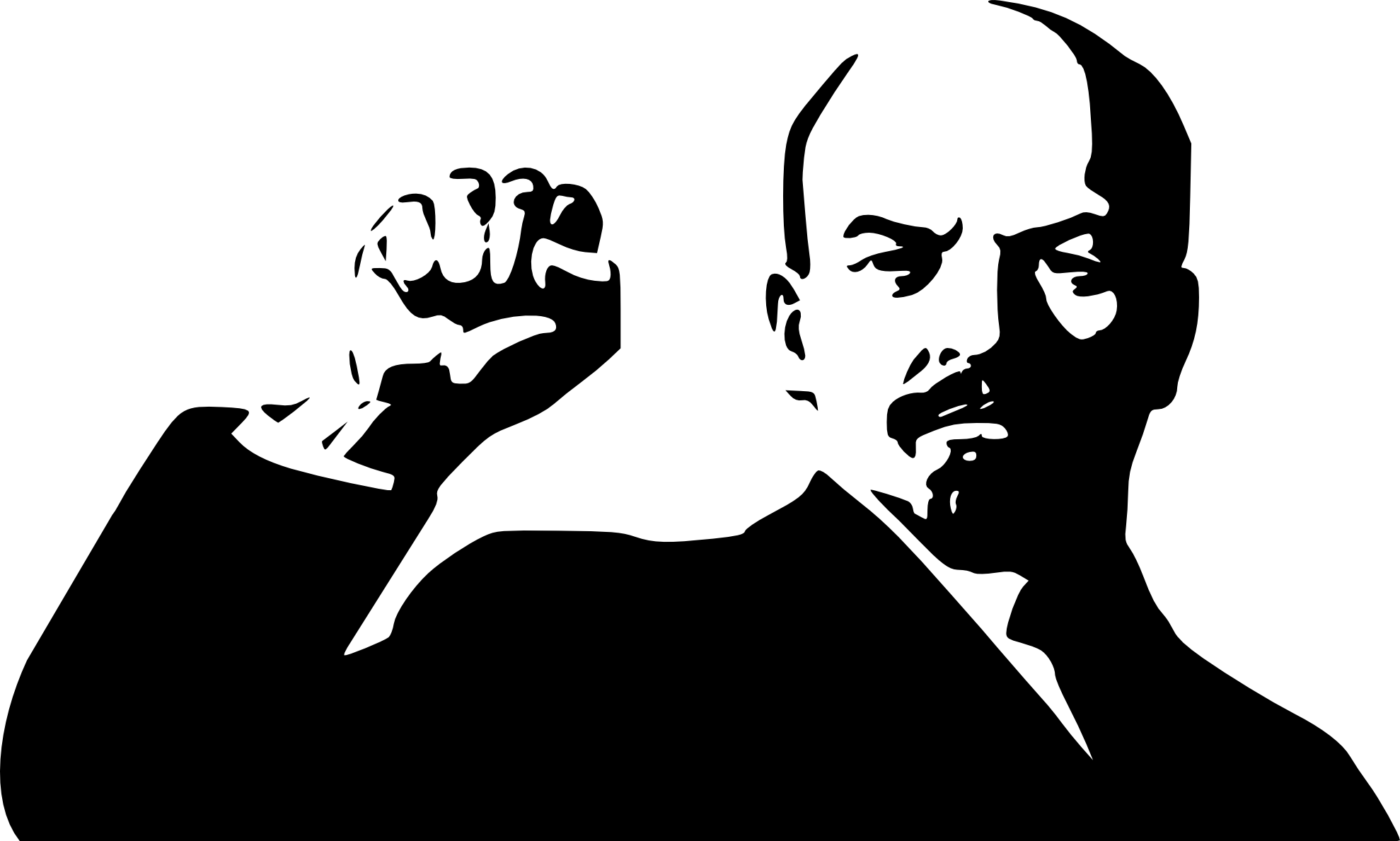 situation where they cannot grasp the division of the people into oor [main village] and cheri [Dalit settlements]. Only once they grasp that can they begin to think about a solution. If you ignore history and campaign on the basis of issues and problems, where do those problems come from? Arunthathiyars have one set of problems; Pallars have distinct issues and Paraiyars have a distinct set of problems. Each existing sub-caste faces specific problems. When you take up one of those issues for political purposes then you end up excluding the next sub-caste. Then caste norms are reinforced; the norms they thought to destroy are being strengthened in this process. This has been a real bonus for the intermediate castes. The main reason for this is the lack of knowledge about Dalit history.
situation where they cannot grasp the division of the people into oor [main village] and cheri [Dalit settlements]. Only once they grasp that can they begin to think about a solution. If you ignore history and campaign on the basis of issues and problems, where do those problems come from? Arunthathiyars have one set of problems; Pallars have distinct issues and Paraiyars have a distinct set of problems. Each existing sub-caste faces specific problems. When you take up one of those issues for political purposes then you end up excluding the next sub-caste. Then caste norms are reinforced; the norms they thought to destroy are being strengthened in this process. This has been a real bonus for the intermediate castes. The main reason for this is the lack of knowledge about Dalit history.
Hugo: Now you mentioned one other issue: The demands raised by Ayothidas Pandithar are still pending.
Sannah: Yes, they are still pending.
Hugo: So, does this mean that there is still untouchability in Tamil Nadu? Do atrocities still occur? Are such issues still continuing?
Sannah: Untouchability? That is; each village is split into oor and cheri. Why do they keep the downtrodden in the cheris? It’s because they are untouchable people – that is why. Now across the world there have been ghettos, there is no country on earth without ghettos. On some basis or other whether that be physical pollution or spiritual pollution, citing pollution of some kind ghettos have been created. As societies have developed, however, and as they have progressed, those ghettoes have ceased to exist. Today there are ghettos for Black Americans, ghettos for Aborigines in Australia but the systematic separation into oor and cheri cannot be found. So long as you have the oor and cheri, it means that untouchability continues to exist. It is clearly visible; no other country has such blatant and openly visible segregation like this. While the situation remains like this in Tamil Nadu, or anywhere across India, how can we say that untouchability has been eradicated? Untouchability persists 100% in all its manifestations today. That is the truth.
Hugo: Now in 1990 people celebrated Ambedkar’s centenary. At that point both Ambedkar’s ideals and the term Dalit spread widely across Tamil Nadu. Can you say a bit about the movements that have been operating since that point. That was when DPI – the Dalit Panther Iyyakkam (Movement) came into the limelight, Puthiya Tamilagam (New Tamil Nadu Party) emerged around that time too. Similarly many other movements were mobilising significantly around that time.
Sannah: Now you know, since the outset I have had a very different opinion on this that I have made clear. Many former writers, intellectuals and thinkers say that it was only after the Ambedkar centenary that Dalit mobilisation occurred in Tamil Nadu.
Hugo: That was when it became widely visible.
Sannah: Maybe, but I disagree with that position. Dalit movements have always been protesting. A movement can only – at best – campaign forcefully for about thirty years. After thirty years, the key players in that movement will grow old – the age-factor plays a role – their boldness will diminish and the next generation will start afresh. This is the trend for social movements around the world. Just look at Tamil history. The movement that emerged in the 1880s stuttered a bit after 1914 when Ayothidasar died. After him, the movement gains strength again after 1919. It continues to be reasonably strong through the 1920s, till the Dravidian movement emerges and dilutes it. Then again in 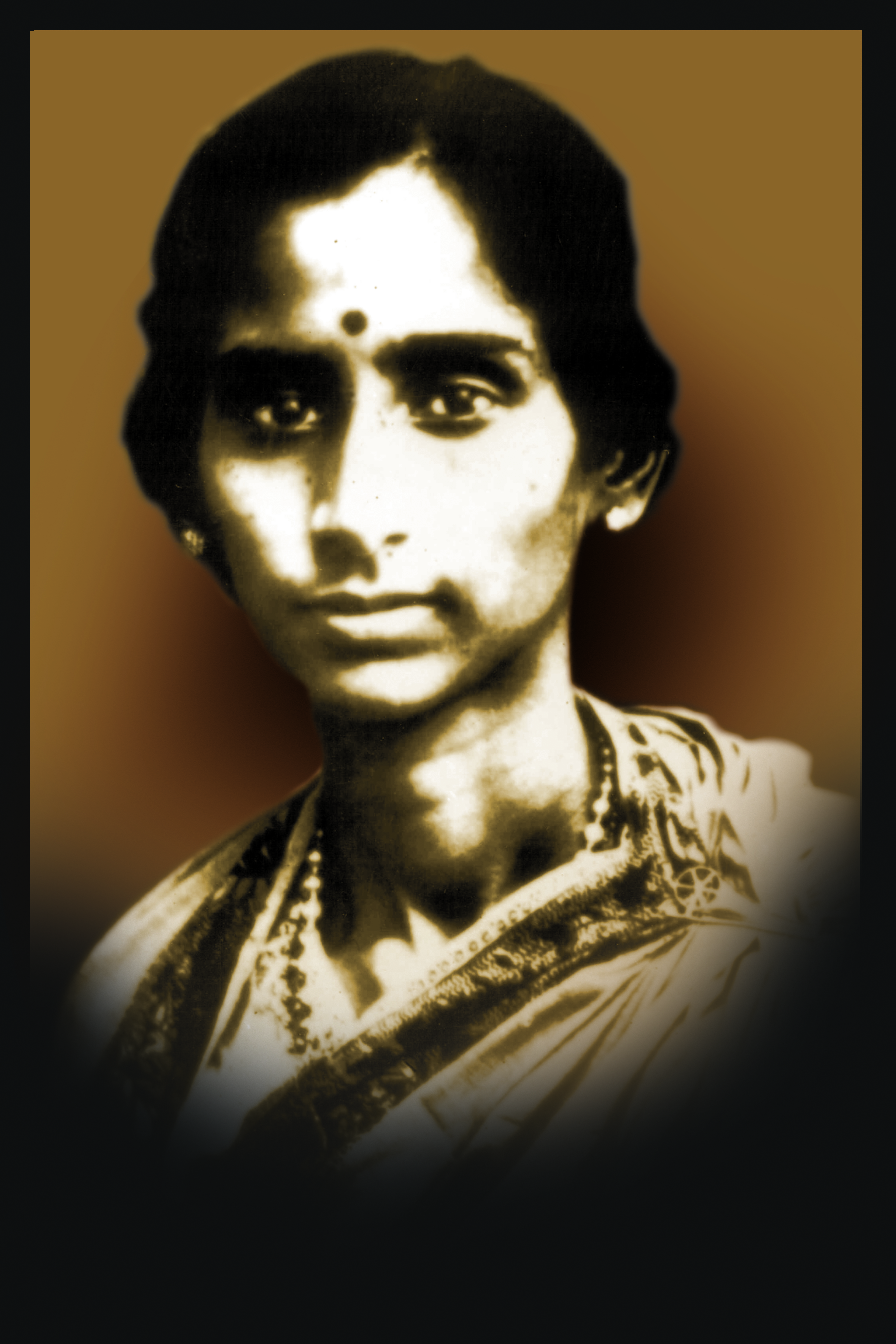 Ambedkar’s time from about 1932 or 1935 even till 1956 the Dalit movement is strong in Tamil Nadu. Again, after Ambedkar’s death it loses ground a bit before local Dalit leaders emerge. After this, between 1960 and 1980 or so, there are lots of little, little leaders in the state. There were also leaders who were spoken about, but who accepts them? They need to be accepted don’t they? No matter how many protests you hold, if you look at major clashes; there have been major clashes before 1990. You will have heard of the Meenakshipuram riot, but the opportunity to record those clashes was absent at that time.
Ambedkar’s time from about 1932 or 1935 even till 1956 the Dalit movement is strong in Tamil Nadu. Again, after Ambedkar’s death it loses ground a bit before local Dalit leaders emerge. After this, between 1960 and 1980 or so, there are lots of little, little leaders in the state. There were also leaders who were spoken about, but who accepts them? They need to be accepted don’t they? No matter how many protests you hold, if you look at major clashes; there have been major clashes before 1990. You will have heard of the Meenakshipuram riot, but the opportunity to record those clashes was absent at that time.
Hugo: Now who are these leaders who emerged in the interim? Vai.Ba [Y. Balasundaram of the Ambedkar People’s Movement] …
Sannah: Y. Balasundaram, Chepen, Elayaperumal, then Sakthidasan like that there is a long list. But no one recognised them at the time. They remained as movements and were not able to enter politics. Then, there is another issue in the pre-1990 period. Before 1990, the Dalit intellectuals of today and the non-Dalit intellectuals who work within the Dalit concept and consciousness – none of them regarded the pre-1990 Dalit movement as ideologically based. They saw even Ambedkar as a caste leader – that is what they thought. In their minds the key theorists were Lenin, Marx, Mao, Stalin and people like that. From this standpoint they perceived the Dalit movements as struggles over land and materialist concerns that is all. They saw Ambedkar as a democrat or a liberal capitalist. That is how they defined him. Consequently they gave no consideration at all to the background, ideology and mobilisation of these movements. If you ask when their opinions begin to alter, then between 1988 and 1991 there is a massive change in Russia. Gorbachev introduces Perestroika to Russia, but it is a failure. Once that fails the Soviet Union collapses and the countries in the Soviet Bloc adopt a democratic and capitalist system. For communist inspired thinkers their minds had been focused on the USSR as the archetypal movement until that point and they did not study movements closer to home. It is only after Perestroika and the change to capitalism in Soviet Russia that there begins to be a change in their analysis. Having seen this they decide that there is no longer any use in talking about what is going on over there. If they look to China, then state capitalism has been introduced there too. It is in the midst of these changes and re-evaluations in their thinking that the Ambedkar Centenary occurs. What happens then is that this lot only start to read Ambedkar at that juncture. Once they start to read him then they start to accept him as a leading ideological thinker and endorse him as such. So what happened was that they have written about their change of mind as though that was a change in wider society. Following this they write that it was after the Ambedkar centenary that Dalit mobilisation took off in Tamil Nadu. Who takes the earlier protests and movements into account?
Hugo: You are right, we should not forget them.
Sannah: No, we cannot forget them, but they are [forgotten]. In that period before 1990 countless Dalit journals were published, but this lot did not even have the heart to read them. What do this lot do? After 1990 when they start to read these journals and Ambedkar’s works, they portray their intervention as significant in the rise of Dalit ideology. Then the myth or the falsehood is that it is only the non-Dalit ideologists who have ideological insight that the Dalits lacked beforehand. By and large, wherever you are, new movements will emerge after about thirty years. Similarly around Ambedkar’s Anniversary Dalit movements regenerated, the Dalit Panther Movement flourished, but it  did not begin in 1990 it started earlier, but after Thirumavalavan assumes leadership some of these non-Dalit ideologists offer support to him and go along with him. This was not the only movement at the time. Puthiya Tamizhagam was there, there were some Arunthathiyar movements, and lots of smaller movements and several caste eradication organisations and fronts were established at this time. In understanding the reason for this uprising, the Ambedkar Centenary is one cause for this lot – it is not a reason for the Dalit movement itself because who else has kept the ideas of Ambedkar alive over all these years?
did not begin in 1990 it started earlier, but after Thirumavalavan assumes leadership some of these non-Dalit ideologists offer support to him and go along with him. This was not the only movement at the time. Puthiya Tamizhagam was there, there were some Arunthathiyar movements, and lots of smaller movements and several caste eradication organisations and fronts were established at this time. In understanding the reason for this uprising, the Ambedkar Centenary is one cause for this lot – it is not a reason for the Dalit movement itself because who else has kept the ideas of Ambedkar alive over all these years?
Hugo: But isn’t it true that it was only in 1987/88/89 that they translated Ambedkar into Tamil?
Sannah: They translated him, yes – but before that many small publications spread his word. Let me ask you one question: Leave aside Ambedkar’s ideas, were there no Ambedkar statues anywhere in Tamil Nadu before that point?
Hugo: There were, but not to the same extent.
Sannah: As far as Ambedkar is concerned people did not read his ideas and then engage in protest. Ambedkar for most is an identity; he worked for us and fought for us and is our Messiah – that is what they think. Due to that they raised Ambedkar statues in village after village and nurtured the protest spirit through that. There is no need for ideology or philosophy to protest with ordinary people. What the non-Dalit thinkers assumed was that you needed an ideological grounding in order to protest, and thus they totally misunderstood this intervening period. So we can say that the 1990 Ambedkar Centenary was an awakening point for non-Dalits, for Dalits it was merely a great opportunity. I think that this position is one that has been totally obscured.
Hugo: Good point, few people talk about this. Academics sat in libraries will talk about Ayothidasar and the continuities in the Dalit movement. It is also clear that movements do not and cannot emerge overnight. The seeds of revolt need to be planted first and we need to dig deep to uncover the pre-history of the movement. You have articulated this more clearly than anyone else I have spoken to. But even now, hardly anyone has worked on the Dalit leaders who existed between 1957 and 1990.
Sannah: They have paid no attention to them at all.
Hugo: They have ignored them and not written about them either.
Sannah: Yes, Sivaraj [Also Shivaraj – President of the Scheduled Caste Federation and, later, President of the Republican Party] was a major leader. He was second only to Ambedkar and constantly by his side but who paid any attention to him? He was one 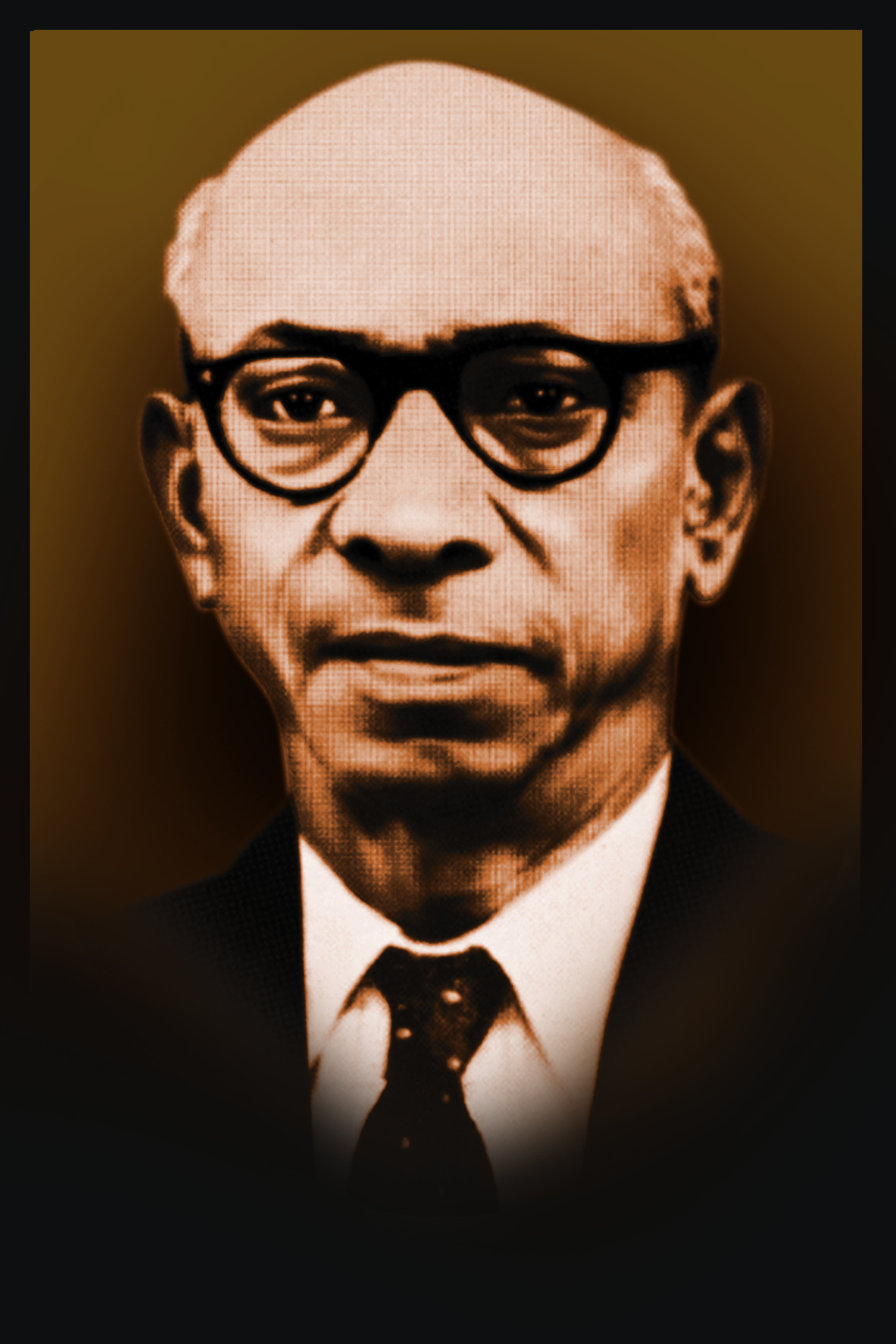 year older than Ambedkar, but no one speaks about him. N. Sivaraj, after Ambedkar’s death, founded the Republican Party that Ambedkar had wanted to found. Ambedkar wanted to form the Indian Republic Party and wrote all the rules and policies for it, but he died before his dream could be realised. N. Sivaraj had a huge role in founding the party and taking it to an all India level. Also at that time there were well known political leaders in Tamil Nadu. Ambedkar died in 1956, this party was founded in 57, in the 1962 election the DMK was allied to the Republican Party. At the time of the alliance the major Dalit leader in Tamil Nadu was Ayra Sankarnan, after him there were Pallikonda. M. Krishnasamy, G. Moorthy, Sakthidasan, Chepen, L.Elayaperumal, Y.Balasundaram and other similar leaders who paved the way for subsequent movements. No one recognised any of these leaders. The Republican Party was established enough for the DMK at that point to need to ally with it. That need was there, for example, in 1962 there was an election and the RPI was in alliance with the DMK. [Sivaraj contested from Vellore in 1962 and came second. He won from Chengalpattu LS constituency in 1957]. Sivaraj contested for the Vellore MP Constituency, but DMK candidates stood for the 6 MLA constituencies that fall within its boundaries. Now, both of them are in alliance and competing together and so both of them should win. If they gain victory then the DMK should win in the 6 MLA seats and the RPI should win the MP constituency. But if you ask what happened there, the big shock was that the 6 DMK candidates all won, but the RPI candidate Sivaraj was made to lose. Whose fault is this? The DMK lot should have voted for him shouldn’t they? How can the DMK which massively betrayed its ally then claim to uphold the rights and identities of the downtrodden? This is the nature of Dravidian parties and the Dravidian movement. Just because these leaders were prevented from speaking does not mean that we can conclude that there was no movement. In sum, in the thirty years between Ambedkar’s death and 1990 there were significant movements working in Tamil Nadu and indeed across India. It is because there was no will to accept and recognise them that this issue arises. It was only after 1990 with the riseof new movements that Dalit activity appeared to their eyes. More specifically, after thecollapse of the Soviet Union.
year older than Ambedkar, but no one speaks about him. N. Sivaraj, after Ambedkar’s death, founded the Republican Party that Ambedkar had wanted to found. Ambedkar wanted to form the Indian Republic Party and wrote all the rules and policies for it, but he died before his dream could be realised. N. Sivaraj had a huge role in founding the party and taking it to an all India level. Also at that time there were well known political leaders in Tamil Nadu. Ambedkar died in 1956, this party was founded in 57, in the 1962 election the DMK was allied to the Republican Party. At the time of the alliance the major Dalit leader in Tamil Nadu was Ayra Sankarnan, after him there were Pallikonda. M. Krishnasamy, G. Moorthy, Sakthidasan, Chepen, L.Elayaperumal, Y.Balasundaram and other similar leaders who paved the way for subsequent movements. No one recognised any of these leaders. The Republican Party was established enough for the DMK at that point to need to ally with it. That need was there, for example, in 1962 there was an election and the RPI was in alliance with the DMK. [Sivaraj contested from Vellore in 1962 and came second. He won from Chengalpattu LS constituency in 1957]. Sivaraj contested for the Vellore MP Constituency, but DMK candidates stood for the 6 MLA constituencies that fall within its boundaries. Now, both of them are in alliance and competing together and so both of them should win. If they gain victory then the DMK should win in the 6 MLA seats and the RPI should win the MP constituency. But if you ask what happened there, the big shock was that the 6 DMK candidates all won, but the RPI candidate Sivaraj was made to lose. Whose fault is this? The DMK lot should have voted for him shouldn’t they? How can the DMK which massively betrayed its ally then claim to uphold the rights and identities of the downtrodden? This is the nature of Dravidian parties and the Dravidian movement. Just because these leaders were prevented from speaking does not mean that we can conclude that there was no movement. In sum, in the thirty years between Ambedkar’s death and 1990 there were significant movements working in Tamil Nadu and indeed across India. It is because there was no will to accept and recognise them that this issue arises. It was only after 1990 with the riseof new movements that Dalit activity appeared to their eyes. More specifically, after thecollapse of the Soviet Union.
Hugo: Just a quick question. Is it right that parties like the RPI never contested on their own symbols but on those of their allies like the DMK or ADMK?
Sannah: Yes, in the early stages (in 1952 and 1957 elections) the Republican Party did stand independently on the Elephant symbol, and on same elections period stood in Assembly election with the Commonweal Party on another symbol – the rising sun- which the DMK later inherited. After that as Dalit parties were unable to muster a large enough vote bank to stand alone they were not able to contest ontheir own symbols. Since their opportunities were so limited – 1 or 2 seats – if they stood with the ADMK they campaigned on the twoleaves, if they stood with the DMK they adopted the rising sun; this is how their movements were suppressed.
Hugo: Is this why the movements that emerged after 1990 boycotted elections and attempted a more radical mobilisation of the people?
Sannah: Yes that is true. If you ask what happens then in elections, Dalits have continuously been unable to claim their share. There are two issues here. The first is that they failed to gain separate electorates in 1935 following the decree in 1932. Instead of separate electorates they gained reserved constituencies. What this means is that the representative in each of these constituencies must be Dalit, but each party puts forward adowntrodden candidate who becomes a party representative rather than a spokesperson for this community. In this manner the political rights that were gained by the Dalits have come to primarily benefit the non-Dalits. This led to a gradual decline in trust in the electoral process and a belief that they needed to shore up Dalit power by some means. Basically the people were repeatedly frustrated by elections, and continuously felt cheated by them. This was especially the case amongst the youth who felt that no party represented them or gave them a voice. At this point, as soon as the Viduthalai Chiruthaigal adopted its election boycott it was taken up with great enthusiasm and radicalism in southern districts particularly in and around Madurai and subsequently it spread across the major part of Tamil Nadu. In addition,boycotting elections continues to be an emotive issue even today. Another factor was communal atrocities. In the 1990s Miss Jayalalitha came to power and promoted several prominent members of the Backward Caste Thevar or Mukulathor Castes. This occasioned great among the entire Mukulathor castes who felt that they are ruling class and have the right to rule over and dominate the Dalits. Dalits, however, did not accept this mind-set which led to multiple caste clashes. In that severe situation Scheduled Caste reserved constituency members were sitting in Assembly as silent spectators and they did not react against communal atrocities. As far as Dalits are concerned, particularly the Dalit youth, this led to immense frustration and a feeling that the present electoral system could not save them. They were, therefore, naturally attracted to the electoral boycott and the radical political mind-set which was articulated by the DPI. That was the social background.
Hugo: Has this casteism now lost its virulence, and have caste-Hindu atrocities diminished?
Sannah: No, not possible, it is still alive. Even now so many incidents are being noticed every day.
Hugo: Is education the key to eradicating untouchabilty? With increased education willthe protection of caste identity and practice of untouchability – at least in virulent forms – slowly decline? I think and hope that education may help to this end.
Sannah: No, I don’t think so, because caste-Hindus today are actually educated caste- Hindus. How can they lose their privileges which have been given to them by the caste system? It is because they want to protect their identity for that, that they profess untouchablity. In addition, there are two kinds of untouchability; one is open untouchablity and another is a more abstract form of untouchablity.
Hugo: What do you mean by this?
Sannah: In future the main challenge will be to identify and contest micro-level, abstract expressions of untouchability. This micro, abstract form of untouchability is particularly prevalent in cities. I strongly draw your attention to the abstract forms of untouchablity so that they can be taken into the political scenario as so academics may also map and find their dynamics and impact in future.
Hugo: We may even be unaware of it.
Sannah: Yes. But it is only if you discover this that there is any opportunity to speak about caste eradication. They can say: ‘Look at me I’m a big man. I have left behind old feelings and am sitting here eating with a Dalit. I am having tea with him’. Just saying that is a form of caste dominance in some ways. This goes on all the time. Then you may come to Madras and live in apartments and say that you are going to talk about Dalit rights, but there will be huts right next to your home and you will not once open your mouth to speak about or to those slum-dwellers. When questioned you will say: ‘These are very ugly people’! This sort of hypocrisy is rife amongst the intellectuals.
Hugo: Not just that, there is also a neglect of their history. For example there is the school of Subaltern Studies – a globally renowned group of historians – who never spoke about Dalits.
Sannah: They did not.
Hugo: But aren’t the Dalits the main subaltern group?
Sannah: Of course. It is only after we levelled these charges against them that they started to become silent and drift away. After a while they thought: ‘why should I speak on Dalit issues when I am abused like this? I’ll stop talking about it’. This is one of the key reasons why non-Dalits are so silent today within intellectual circles. Otherwise they should still be raising their voices shouldn’t they?
Hugo: There are people, like V. Geetha and others, who are writing about the Dalit movement aren’t there?
Sannah: That is an attempt to counter – well not even counter but to defend themselves against the charges we have made. So rather than seeing the Dalit movement as emerging overnight in 1990 we can see that there is a long-running process of mobilisation. Once that was given direction and energy in the 1990s Dalit politics took it up and started to run with it. If you asked what fear this created in Government; then these radical movements which were boycotting the elections were rallying the lower 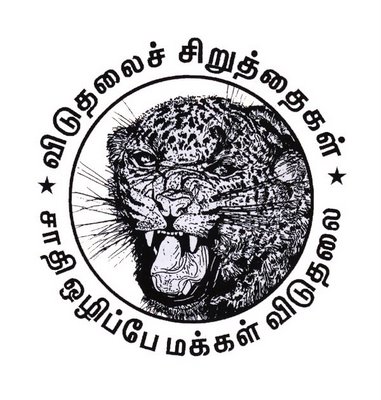 castes. There was a fear that they might become Naxalbari movements [radical left movements which owe their name to Naxalbari Village in West Bengal]. That was the fear that existed. Once this challenge to legitimacy was felt by the Dravidian political parties all the political parties joined hands to put pressure on the Dalit movements. They started foisting cases on people, instigating riots and so on with the view to bringing them into parliamentary democracy through such pressure. Simultaneously we have to ask what the result of the movements who boycotted elections from 1990 to 1998-89 was. Their result was that they could organise the people, give a face to people’s sufferings, hit back when attacked but this alone cannot be the sole purpose of a political party.
castes. There was a fear that they might become Naxalbari movements [radical left movements which owe their name to Naxalbari Village in West Bengal]. That was the fear that existed. Once this challenge to legitimacy was felt by the Dravidian political parties all the political parties joined hands to put pressure on the Dalit movements. They started foisting cases on people, instigating riots and so on with the view to bringing them into parliamentary democracy through such pressure. Simultaneously we have to ask what the result of the movements who boycotted elections from 1990 to 1998-89 was. Their result was that they could organise the people, give a face to people’s sufferings, hit back when attacked but this alone cannot be the sole purpose of a political party.
Hugo: They were also important in raising awareness.
Sannah: Yes, this was a strategy to educate people politically. After this, the next step had to be an attempt to seize power from whoever was excluding the downtrodden people. This is a natural outcome of political growth. Then those parties boycotting the elections reached the point where they needed to take power away from the powerful or assume power themselves. It was in the belief that this would help further dilute marginalisation that people joined the Viduthalai Chiruthaigal and that is why they decided to take part in elections. No sooner had they done so than the necessity to engage in electoral work and consider electoral alliances arose. But it has to be said that they made full use of their thirty-year cycle – which I talked about earlier – to mobilise and protest for the people.
Hugo: Okay. Up until 1999 you said that electoral politics was the path of scoundrels and that politics was a sewer. Now you have entered that sewer. Not just the VCK but Puthiya Tamilagam and others. Having entered the sewer how have you dealt with Dalit issues?
Sannah: In the first election the leaders of the time joined hands with G. K Moopanar (founder and president of Tamil Manila Congress- Tamil State Congress) in a Third Front and tried to create a new, alternative front. The aim after that election was to create a non-DMK or ADMK force and to rally VCK, PT and intermediate castes’ parties. However, Moopanar did not agree to this and following the 1999 elections he joined hands with the ADMK. After that, in every election, whether it be the one in 2001 or 2006 or the one in 2011, the VCK’s position has been to forge a non- Dravidian 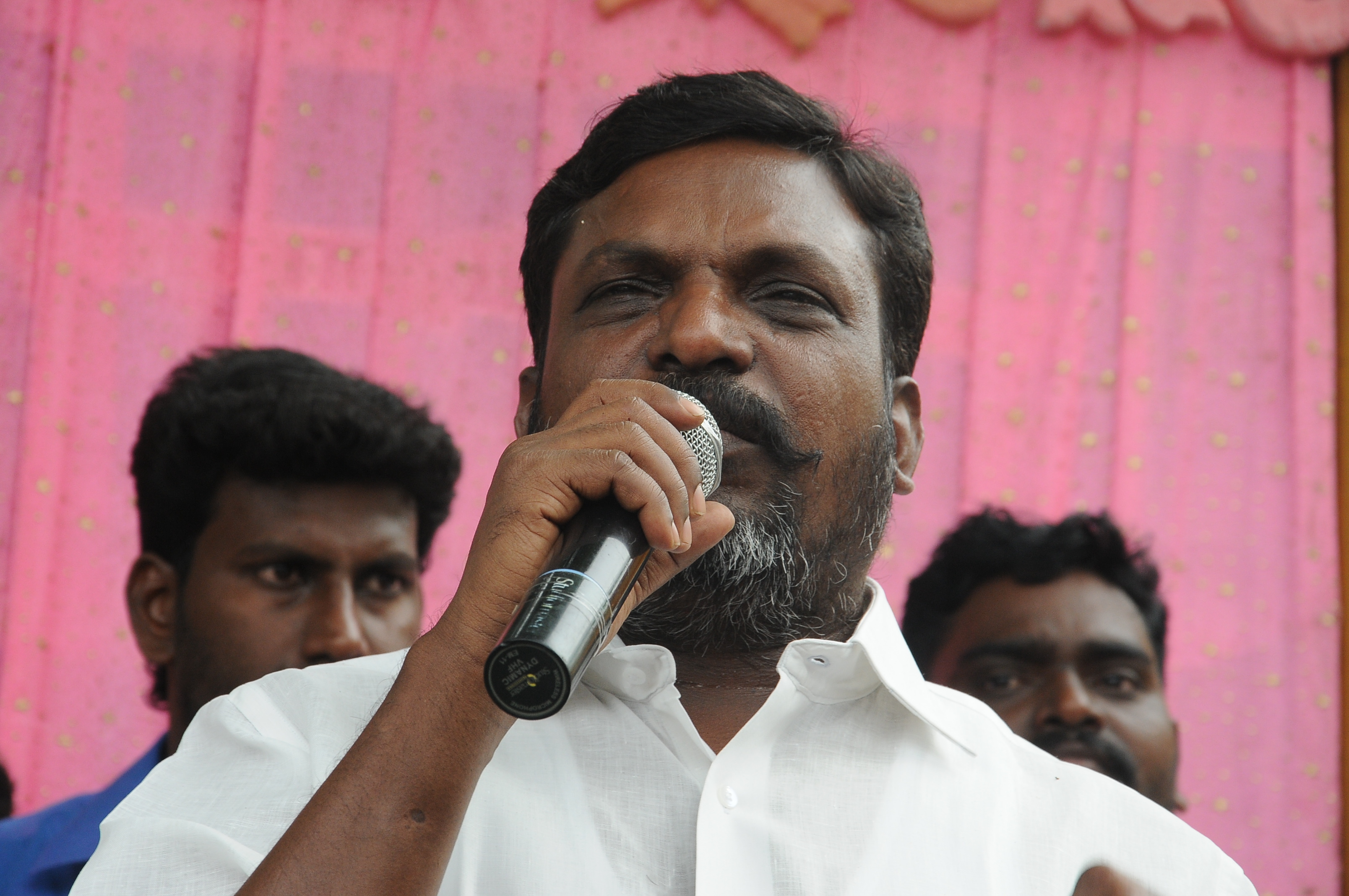 alternative front. They have worked extremely hard to this end, but they have not once been successful in this endeavour. Had they succeeded then perhaps Tamil politics would have changed. There would have been an opportunity to change. As far as the VCK are concerned, they have the desire to change, but the other parties lack the heart to recognise their efforts. For example let us take Dr. R. Ramadoss; Ramadoss tried to unite downtrodden people; fisher-folk, Muslims with the intermediate castes. He joined with us in the Tamil Protection Front and has a similar position on Eelam, but he has never been willing to contest an election with us as part of a Third Front. In 2009 The VCK tried to create a Third Front; our leader Thol. Thirumavalavan made determined efforts to forge an alternative. At the same time in 2007, a Dalit ideal emerged; that ideal stated that in Tamil Nadu; if Dalits, Muslims, Christians, Tribals, Fisherfolk, and similar minorities and then the PMK and other intermediate castes could be united as a political force then that would bring about a major change in Tamil Nadu politics. Politically speaking such a political force would create an alternative to the DMK and ADMK. This view came to the fore, most radically in the 1996 election. Back in the 1996 election they tried to fulfil this ideal to some extent. Once they had done that then all non-Dalit castes created caste parties too. All those parties united and joined in coalition with the DMK in the 1996 election. As soon as they did they suffered a major defeat. Having been burned by the experience they determined never to ally with explicitly caste-based parties again. This was the stance taken by the DMK post 1996. Then that became a separate front. So at the time when they were thinking to create an alternative, the DMK used these parties for its own ends. Once that had happened, the trust vested in the smaller parties evaporated and the trend towards an alternate front gradually disappeared. This was the time when Puthiya Tamilagam entered elections and the VCK considered following suit. After that in 1999 and the 2001 elections the DMK were very clear that they would not ally with caste parties, but they allied with parties that do not openly call themselves caste parties. The VCK did not get an opening there as a result, and were compelled to ally with the ADMK. The ideal of an alternative which emerged at that time, however, has been a central plank of VCK policy and the party – especially our leader Thol. Thirumavalavan. We have tried again and again, even up to the 2011 elections to realise such a front. Unfortunately, those attempts have failed. This is what happened in successive elections after 1999. The underlying truth is that though the VCK have entered party politics they have remained true to their ideals; they just have not been able to put them into practice.
alternative front. They have worked extremely hard to this end, but they have not once been successful in this endeavour. Had they succeeded then perhaps Tamil politics would have changed. There would have been an opportunity to change. As far as the VCK are concerned, they have the desire to change, but the other parties lack the heart to recognise their efforts. For example let us take Dr. R. Ramadoss; Ramadoss tried to unite downtrodden people; fisher-folk, Muslims with the intermediate castes. He joined with us in the Tamil Protection Front and has a similar position on Eelam, but he has never been willing to contest an election with us as part of a Third Front. In 2009 The VCK tried to create a Third Front; our leader Thol. Thirumavalavan made determined efforts to forge an alternative. At the same time in 2007, a Dalit ideal emerged; that ideal stated that in Tamil Nadu; if Dalits, Muslims, Christians, Tribals, Fisherfolk, and similar minorities and then the PMK and other intermediate castes could be united as a political force then that would bring about a major change in Tamil Nadu politics. Politically speaking such a political force would create an alternative to the DMK and ADMK. This view came to the fore, most radically in the 1996 election. Back in the 1996 election they tried to fulfil this ideal to some extent. Once they had done that then all non-Dalit castes created caste parties too. All those parties united and joined in coalition with the DMK in the 1996 election. As soon as they did they suffered a major defeat. Having been burned by the experience they determined never to ally with explicitly caste-based parties again. This was the stance taken by the DMK post 1996. Then that became a separate front. So at the time when they were thinking to create an alternative, the DMK used these parties for its own ends. Once that had happened, the trust vested in the smaller parties evaporated and the trend towards an alternate front gradually disappeared. This was the time when Puthiya Tamilagam entered elections and the VCK considered following suit. After that in 1999 and the 2001 elections the DMK were very clear that they would not ally with caste parties, but they allied with parties that do not openly call themselves caste parties. The VCK did not get an opening there as a result, and were compelled to ally with the ADMK. The ideal of an alternative which emerged at that time, however, has been a central plank of VCK policy and the party – especially our leader Thol. Thirumavalavan. We have tried again and again, even up to the 2011 elections to realise such a front. Unfortunately, those attempts have failed. This is what happened in successive elections after 1999. The underlying truth is that though the VCK have entered party politics they have remained true to their ideals; they just have not been able to put them into practice.
Hugo: OK, now it is essential to work with the Dravidian parties; do they give you recognition within their coalitions? Do they engage in grassroots work during election campaigns? Do they vote for you? Do they give your leader respect on their stages? What is the situation in their coalitions?
Sannah: Now if we must look at both parties, the ADMK today has changed into a Thevar party; a Mukkulathor party. The day that Jayalalitha joined forces with Sasikila it turned into a Mukkulathor party. This side, in the north, the Vanniyar votes are split into two vote-banks: the first is the Paatali Makkal Katchi and the second is the DMK. As far as the ADMK are concerned, their Vanniyar votebase is very small. When the VCK joins forces with the ADMK, the VCK have authority in the northern districts, but the ADMK do not, having said which many of the downtrodden people are with the ADMK. For all these reasons the VCK gained a certain respect from the ADMK. As far as the DMK are 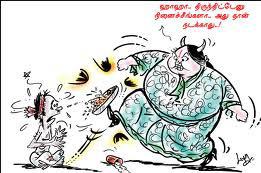 concerned, the respect that we get on platforms and stages we do not receive at the grassroots. On stages our leaders can sit on a par with Karunanidhi; we can campaign on their platforms and they will come and campaign on our stages, but the respect that we got on the platforms we did not get on the ground. At the same time with the ADMK, in southern districts the VCK gets no respect on the ground because the ADMK’s base there is the Mukkulathors. In this society we can only ask which stages we are accepted onto. When looking at it like that, having entered the sewer of politics the main difference between the ADMK and DMK is like that. Looking at it like that, though the ration might vary very slightly, we have not received full acceptance or recognition from either party. They totally see us as ‘just a Dalit party’ and it could take some time before that perception changes.
concerned, the respect that we get on platforms and stages we do not receive at the grassroots. On stages our leaders can sit on a par with Karunanidhi; we can campaign on their platforms and they will come and campaign on our stages, but the respect that we got on the platforms we did not get on the ground. At the same time with the ADMK, in southern districts the VCK gets no respect on the ground because the ADMK’s base there is the Mukkulathors. In this society we can only ask which stages we are accepted onto. When looking at it like that, having entered the sewer of politics the main difference between the ADMK and DMK is like that. Looking at it like that, though the ration might vary very slightly, we have not received full acceptance or recognition from either party. They totally see us as ‘just a Dalit party’ and it could take some time before that perception changes.
Hugo: Do their votes fall for the VCK? Look at the last election. In 2011, PMK, DMK and VCK were all in the one front. In northern districts Vanniyars are either in the PMK or the DMK, the Dalits are with the VCK. If all three sets of followers vote according to this, then we should have won in at least 2 or 3 constituencies shouldn’t we? (Sannah: Mmm.) But you did not win in a single seat.
Sannah: Now, in terms of vote banks. The way we should analyse the 2011 election is that – this is how everyone sees it – there is a perception that the PMK is totally a Vanniyar party, but Vanniyars are not united – this is important. There are two types of Vanniyar: the first are the Tamil-speaking Vanniyars and the second are the Telegu-speaking Vanniyars. The Telegu-speaking Vanniyars are one community force; the Tamil-speaking Vanniyars are a different group. Those behind Ramadoss are, generally speaking, the Tamil speakers. The Telegu-speaking agni-kulu Vanniyars – Naidus, Reddiyars and so on, unite with other Teleguspeaking intermediate castes. They do not accept Ramadoss’ leadership. That is one thing. Secondly, the Telegu-speaking Vanniyars within the DMK – the authority rests with the wealthy Telegu-speaking Vanniyar candidates; that is why they are in that party. In 2011 Vijayakant’s campaign split the Telegu Vanniyar vote. The PMK vote bank diminished and the DMK vote-bank shrunk too. In this situation the Telegu-speaking Vanniyars have no need to accept or work with VCK candidates. The Tamil-speaking Vanniyars in either the DMK or ADMK – there is little chance that they will fully endorse the VCK either. When someone who was working under them until yesterday suddenly stands as an MLA candidate, they do not have the will to view them as equals and so they withheld their votes too. As far as the downtrodden are concerned, they see voting as one of their main tasks but they are not yet politically conscientised to vote for one of their own, so their votes are still distributed amongst parties. Dalit votes fell for non-Dalit candidates, but thevotes of the non-Dalits were not cast for Dalit candidates. This is the backdrop and underlying reason for the VCK’s loss in 10 seats. The Vanniyar votes and the other intermediate caste votes did not fall for the VCK. That is the truth. What should have happened is that their leaders should have given their followers requisitetraining. Had that happened then the chances of a DMK front defeat would have been eliminated.
Hugo: I accept the truth of this, but I’d contend that the VCK need to provide the same training too because …
Sannah: That’s true enough, it is definitely needed.
Hugo: For example in Sholavandan
constituency, VCK cadres on the ground worked for the ADMK. If you ask on what basis they did that, they say that the PMK candidate there was Pallar whereas the ADMK candidate was Paraiyar and they wanted to give a Paraiyar a chance in their constituency. Many stood by their candidate but an equal number campaigned for the opposing party.
Sannah: That is, as you say, VCK comrades also definitely need that sort of political training. If caste feeling raises its head then this problem will arise everywhere. Also, one cannot say from this that all VCK cadres would behave the same if this occurred in 10 other constituencies. You also need to understand the local dynamics. When local caste frictions exist then there is a greater likelihood that cadres will work for the opposing caste candidate. We need to provide that training in future, we cannot forget that we are lacking in that department. We cannot pretend that caste equations do not matter in the VCK. We cannot expect that and this change needs to be brought about within the VCK as well.
Hugo: OK, now you have changed into a party. No Dalit party in Tamil Nadu can win with Dalit votes alone.
Sannah: They cannot, that is for sure.
Hugo: To win they need the votes of other castes. On those grounds – whether it be PT or VCK – you are speaking a lot about Tamil Nationalism now and you are bringing non- Dalits into the party and giving them posts. Could you say a bit about this please?
Sannah: Now, like you say, within Tamil Nadu people operate within a narrow sphere. There is a common perception of the VCK as a Dalit people’s party. Now if you look at Ambedkar’s writing on Dalits he refers to them as a majority people, but a ‘scattered majority’ – a majority that has been widely scattered – if you look at this scattered majority within any given locality they are a minority. So when you look at their position within a constituency they are in the minority. Across India they form a huge population, but in each area they can only be small parties. You cannot expect Dalitparties to gain power with such a vote-bank, lots more work is needed before that can happen. At the same time there is a belief that if the downtrodden can gain recognition within wider society then they can be victorious. Forexample, Ambedkar started the Independent Labour Party which had both Dalits and non- Dalits as members. After a while what he does is that he changes it to the Scheduled Castes Federation (SCF). When the situation called for separate SC [Scheduled Caste] politics he thought to organise the downtrodden into a political force first of all before reaching out to others. What happened after that was that he introduced the new idea of the Indian Republican Party. Now look at these differences: first of all Independent Labour Party, then SCF, then the Republican Party. So he began by trying to create a common face – a common identity, but that did not become a success. He then emphasises caste identity, that does work to 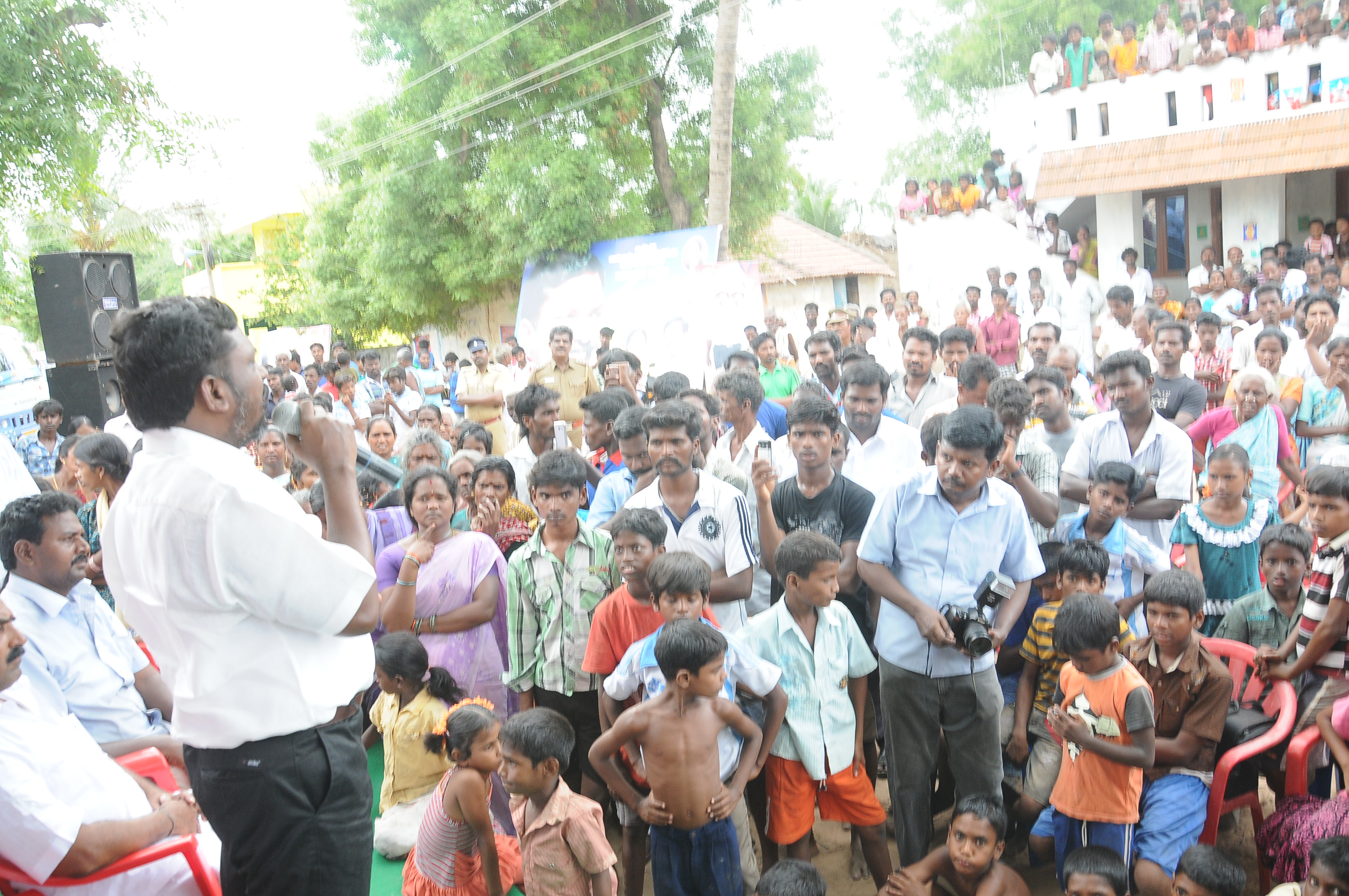 some extent but he feels that if he keeps on with this then caste identity will become a hindrance and so he forms a democratic party in the form of the RPI. This reflection and consideration may be found in all parties in India. In some form or other they have adopted this strategy. Look in TN, first there was the Republican Party, then parties formed for the Adi-Dravidas, then a party for Pallars, then a party for Paraiyars and Arunthathiyars were formed. What happens is that, having formed them, they continue for a time as movements but as soon as they become parties they cannot stand on a caste basis so what do they do? Viduthalai Chiruthaigal; Puthiya Tamilagam, Paatali Makkal Katchi, etc. – they create parties with common names. Then if we are forming parties with common names and trying to rally the people we have to find common cause and we can only go to the nation. This is the only opportunity, and thus Tamil nationalism is the only possible plank. So some parties of the downtrodden have adopted the concept of Tamil nationalism. This is one step on the journey towards a common identity. At the same time, when the Tamils were oppressed in Sri Lanka, generally speaking it is oppressed people who gave a voice to the oppressed; whilst other parties here all gave Tamils a voice politically, their emotive connection with the issue of Eelam was lacking. Here it is the downtrodden people who have experienced oppression and there the Tamils are most oppressed – whether they be in the Tigers or in other organisations, 80% of the people are downtrodden people. When they took up Tamil identity in the face of Sinhala oppression it was felt that this identity could secure a common identity for us here. It is in that belief those downtrodden parties are advancing the concept of Tamil nationalism. Even though there is a serious question as to whether Tamil nationalism would deliver liberation, this is a journey towards a common identity. If this is recognised and accepted then caste feelings will really diminish, caste politics will lessen and this will facilitate the emergence of a truly democratic politics – that is the hope with which Tamil nationalism has been adopted. As far as the VCK are concerned, even when they were radically opposed to elections they spoke of Tamil nationalism. Whilst speaking like this even, they viewed other Tamil nationalist speaking movements with scepticism and wondered how committed they were to the cause. Since entering electoral politics they have continued to speak of Tamil nationalism. Having entered electoral politics there is no need for Tamil nationalism is there? They do not need to speak of this. So to some extent they have established some trust on this issue and Tamil nationalism has afforded the VCK an opportunity to gain some acceptance and recognition in the public sphere. This was accepted as a matter of course in the party. Between 1998 and 2008, they spoke of Tamil nationalism but they also spoke of downtrodden leadership. Only the downtrodden can lead, just as the labouring masses called for labour leaders, so the downtrodden called for the downtrodden to lead on the issue of Tamil nationalism. At that point even some intermediate caste parties accepted that argument. At this point the VCK spoke of Dalit leadership, but there were no non-Dalits in the party. Whether they speak of this or not, Dalits are leaders in this party. Then the party has to be democratised and brought into line with other democratic parties; if we bring non-Dalits who truly desire Tamil nationalism into the party then the concept of Dalit leadership would make sense. On that basis what do they do in 2008 – they focus on this concept
some extent but he feels that if he keeps on with this then caste identity will become a hindrance and so he forms a democratic party in the form of the RPI. This reflection and consideration may be found in all parties in India. In some form or other they have adopted this strategy. Look in TN, first there was the Republican Party, then parties formed for the Adi-Dravidas, then a party for Pallars, then a party for Paraiyars and Arunthathiyars were formed. What happens is that, having formed them, they continue for a time as movements but as soon as they become parties they cannot stand on a caste basis so what do they do? Viduthalai Chiruthaigal; Puthiya Tamilagam, Paatali Makkal Katchi, etc. – they create parties with common names. Then if we are forming parties with common names and trying to rally the people we have to find common cause and we can only go to the nation. This is the only opportunity, and thus Tamil nationalism is the only possible plank. So some parties of the downtrodden have adopted the concept of Tamil nationalism. This is one step on the journey towards a common identity. At the same time, when the Tamils were oppressed in Sri Lanka, generally speaking it is oppressed people who gave a voice to the oppressed; whilst other parties here all gave Tamils a voice politically, their emotive connection with the issue of Eelam was lacking. Here it is the downtrodden people who have experienced oppression and there the Tamils are most oppressed – whether they be in the Tigers or in other organisations, 80% of the people are downtrodden people. When they took up Tamil identity in the face of Sinhala oppression it was felt that this identity could secure a common identity for us here. It is in that belief those downtrodden parties are advancing the concept of Tamil nationalism. Even though there is a serious question as to whether Tamil nationalism would deliver liberation, this is a journey towards a common identity. If this is recognised and accepted then caste feelings will really diminish, caste politics will lessen and this will facilitate the emergence of a truly democratic politics – that is the hope with which Tamil nationalism has been adopted. As far as the VCK are concerned, even when they were radically opposed to elections they spoke of Tamil nationalism. Whilst speaking like this even, they viewed other Tamil nationalist speaking movements with scepticism and wondered how committed they were to the cause. Since entering electoral politics they have continued to speak of Tamil nationalism. Having entered electoral politics there is no need for Tamil nationalism is there? They do not need to speak of this. So to some extent they have established some trust on this issue and Tamil nationalism has afforded the VCK an opportunity to gain some acceptance and recognition in the public sphere. This was accepted as a matter of course in the party. Between 1998 and 2008, they spoke of Tamil nationalism but they also spoke of downtrodden leadership. Only the downtrodden can lead, just as the labouring masses called for labour leaders, so the downtrodden called for the downtrodden to lead on the issue of Tamil nationalism. At that point even some intermediate caste parties accepted that argument. At this point the VCK spoke of Dalit leadership, but there were no non-Dalits in the party. Whether they speak of this or not, Dalits are leaders in this party. Then the party has to be democratised and brought into line with other democratic parties; if we bring non-Dalits who truly desire Tamil nationalism into the party then the concept of Dalit leadership would make sense. On that basis what do they do in 2008 – they focus on this concept
Hugo: The Velachery (VCK headquarters) declaration?
Sannah: The Velachery declaration. They bring that declaration forward in September 2007. Following that, all posts in the party were dissolved and in all areas people were asked to apply and new post-holders were announced in which Dalits, Muslims, and non-Dalits were included from 21st March 2008 and new postholders took office. Tamil nationalism was one reason for the integration of non-Dalits into the party, and this also created an opportunity to democratise the party.
Hugo: This is a welcome change, but what the cadres in the party are saying is that ‘we have been running round working for this party for twenty years; we have been beaten; we have been to prison. Suddenly, because we are now a party, non-Dalits are joining the party in order to get posts’. Have the grassroots members of the VCK accepted the non-Dalits?
Sannah: Now just as there is scepticism over whether non-Dalits can accept Dalits or not, that same scepticism exists amongst the Dalits of the VCK. It is not going to be absent there. We also cannot pretend that it is not there. If you ask why I am saying this, then a party is merely an expression of society. When you finish your party work you have no option but to go home. When you go home, likewise, you cannot abandon your party work. Party and society are one; so whatever problems you encounter in society you will also find in the party. You cannot look at them in isolation. If someone near his house is excluding a Dalit; burning his house; creating caste clashes, and doing all this sort of stuff. Then why would scepticism not arise within the party? It will definitely be there. Only when society changes will this scepticism diminish within the party. Whilst social organisations retain this emphasis, caste-based outlooks will remain. What needs to happen is for those in leadership positions to understand this and create opportunities for a change of heart. As an organisation we need to give training to that end; we have been doing so and are going to redouble our efforts in this area. When doing that, as you say, you get people saying: ‘I’ve been in the party for 20 years, why am I not recognised?’ That very thought is mistaken, because this is political recognition in some ways. If we see it as non-Dalits accepting their leadership and entering the party then it is a form of recognition and we need to get this point across, but it will take time.
Hugo: Now, non-Dalits are coming into the party. Are they joining as individuals or as part of a group?
Sannah: Non-Dalits, in the current trend, are joining as individuals.
Hugo: Then this is not a major boost for electoral prospects; but if we leave elections aside for the minute is there any social gain to the inclusion of non-Dalits in the party?
Sannah: Now, only after we ntered electoral politics and embarked on the democratic process has such an opportunity arisen. Had we maintained the election boycott then opportunities for such interaction would have been very limited, because though non- Dalits are joining us it is highly unlikely that they are joining us with a radical mind-set. They are a democratic force that is all. The radically-minded intermediate castes were with the VCK even when we were boycotting elections and remain here now. They did not join with the aim of gaining electoral positions or success and do not expect such rewards now. They are working behind the scenes in the party and at the grassroots. We can say that they are one of the pillars of the party. But the small groups of people joining now, they are merely democratic forces. The party can use them and they use the party. This is continuing as a mutual understanding at present and we hope that this will gradually change over time.
Hugo: But since they have joined the party, and because we are allying with other parties such as the PMK, Moovendra Munnetra Kazhagam (Thevar Progressive Federation – a Thevar-dominated party based in South TN) or Kongu Nadu Munnetra Kazhagam (Kongu Land Progressive Federation – a party run by intermediate Gounder caste people from western TN), has caste violence reduced?
Sannah: It has definitely reduced!2 If you look at things from a different perspective then the fact that we are giving non-Dalits posts within the VCK sends a clear signal to other parties and castes: ‘Your people are also in this party’. Hitherto our opportunities to get close to other castes and parties were very limited; we could not speak directly to leaders. Such leaders do not have the heart to speak to Dalit leaders, there is a mental block. What this means is that when it comes to discussing coalitions, bargaining for seats or negotiating issues then the non-Dalits in our party are extremely useful. What this means is that if there is a caste clash anywhere or a problems then it is easier for our non-Dalit leaders to speak to non-Dalit leaders on the ground. This helps us to keep the peace and to resolve issues, and non-Dalits in the VCK have played a huge role in this. We should recognise and respect that role and realise that this is one path towards a more harmonious society.
Hugo: Okay, good, but at the same time if you look at what happened in Paramakudi [where 6 Dalits were killed in police firing and baton charges in September 2011] – at the heart of that conflict was the assertion that Dalits should not use the term Guru Puja, or DeivaMagan (Son of God) as they see these terms as reserved for their own leader. Thevars asked how Immanuel Sekaran could be spoken about in such terms. At that point couldn’t the non-Dalit comrades in the party intervene to resolve things?
Sannah: You are right, the problem that arose there was not one that happened suddenly or unexpectedly. In that area what the Mukkulathors think is that Guru Puja is a term reserved for Muthuramalinga Thevar and they are militant about this. It is since the Guru Puja for Immanuel Sekaran has begun to rival their one that the problem has arisen. The Paramakudi shootings did not just happen on that day, the roots of the shooting go back to when the Immanuel Sekaran Guru Puja began. They see it as a competition and are determined to stop it. It is a clear case of competition; and it is a very emotive issue. You cannot resolve these emotions just by having two or three leaders sit down to discuss the matter. This is a continuation of the conflict between Muthuramalinga and Immanuel Sekaran that began in 1950. The two have both died ![]() now, but the conflict persists and we cannot expect to intervene and resolve it immediately. The people with the opportunity to stop this are in this party alone. That is why even in the 2011 election we gave the Madurai Mayoral seat to Mukkaiah Thevar’s (All India Forward Block MLA and Thevar leader) son Ganesan (in the party his name is Thiruma Pasumpon which is a combination of Thiruma = Thirumavalavan and Pasumpon = Muthuramalinga Thevar’s birthplace). He left the party – that is a different matter – but because he stood on our behalf then Mukkulathors outside of Paramakudi had faith that caste riots would not emanate from the Panthers, and trusted that the Panthers would not cause problems for them. Though he left the party many had already had a change of heart. To my knowledge in one village there were 500 Pillai castes who switched allegiance en masse to the VCK. That was during the VCK membership campaign. Following our party president Thol. Thirumavalavan’s advice, we held membership drives between 2009 and 2011 and recruited more than 45 lakhs members into the party in Tamil Nadu and Pondicherry within two years. I am the organiser of that great mission and it is continuing and furthering the cause of the movement. In this membership drive many Mukkulathors joined the party, many Pillaimars joined, many Naidus joined, many Gounders joined – this is a result of the membership drive that we held and the elevation of non-Dalits to leadership positions. So the non-Dalits in the VCK play a vital role in controlling caste clashes and riots.
now, but the conflict persists and we cannot expect to intervene and resolve it immediately. The people with the opportunity to stop this are in this party alone. That is why even in the 2011 election we gave the Madurai Mayoral seat to Mukkaiah Thevar’s (All India Forward Block MLA and Thevar leader) son Ganesan (in the party his name is Thiruma Pasumpon which is a combination of Thiruma = Thirumavalavan and Pasumpon = Muthuramalinga Thevar’s birthplace). He left the party – that is a different matter – but because he stood on our behalf then Mukkulathors outside of Paramakudi had faith that caste riots would not emanate from the Panthers, and trusted that the Panthers would not cause problems for them. Though he left the party many had already had a change of heart. To my knowledge in one village there were 500 Pillai castes who switched allegiance en masse to the VCK. That was during the VCK membership campaign. Following our party president Thol. Thirumavalavan’s advice, we held membership drives between 2009 and 2011 and recruited more than 45 lakhs members into the party in Tamil Nadu and Pondicherry within two years. I am the organiser of that great mission and it is continuing and furthering the cause of the movement. In this membership drive many Mukkulathors joined the party, many Pillaimars joined, many Naidus joined, many Gounders joined – this is a result of the membership drive that we held and the elevation of non-Dalits to leadership positions. So the non-Dalits in the VCK play a vital role in controlling caste clashes and riots.
Hugo: Now Dalit cadres are a bit scared by this. Now there are many non-Dalits in the party meaning that non-Dalits believe that caste clashes will not arise. What Dalit comrades say about this, though, is: ‘if any problems arise then we will compromise; we are backtracking from earlier positions and have abandoned Dalits’. This is a fear that many grassroots, village Dalits have. What do you say about that?
Sannah: That is true enough, this fear is genuine because the Viduthalai Chiruthaigal is a party that has advanced the issues of the downtrodden – specifically Dalits – and acted on their grievances. As many non-Dalits are joining the party now there is an accusation that they are benefiting unduly from this. Of course there will be this suspicion and we cannot avoid that. What we need to ask is what political benefit the VCK have had from their membership; what they have achieved? Looking at that too, there are very few advantages. We have won only one MP seat and have lost 10 MLA seats. Now only if we succeed politically can we resolve issues at the grassroots and have the opportunity to debate these issues. If we stand only as Dalits, however, we 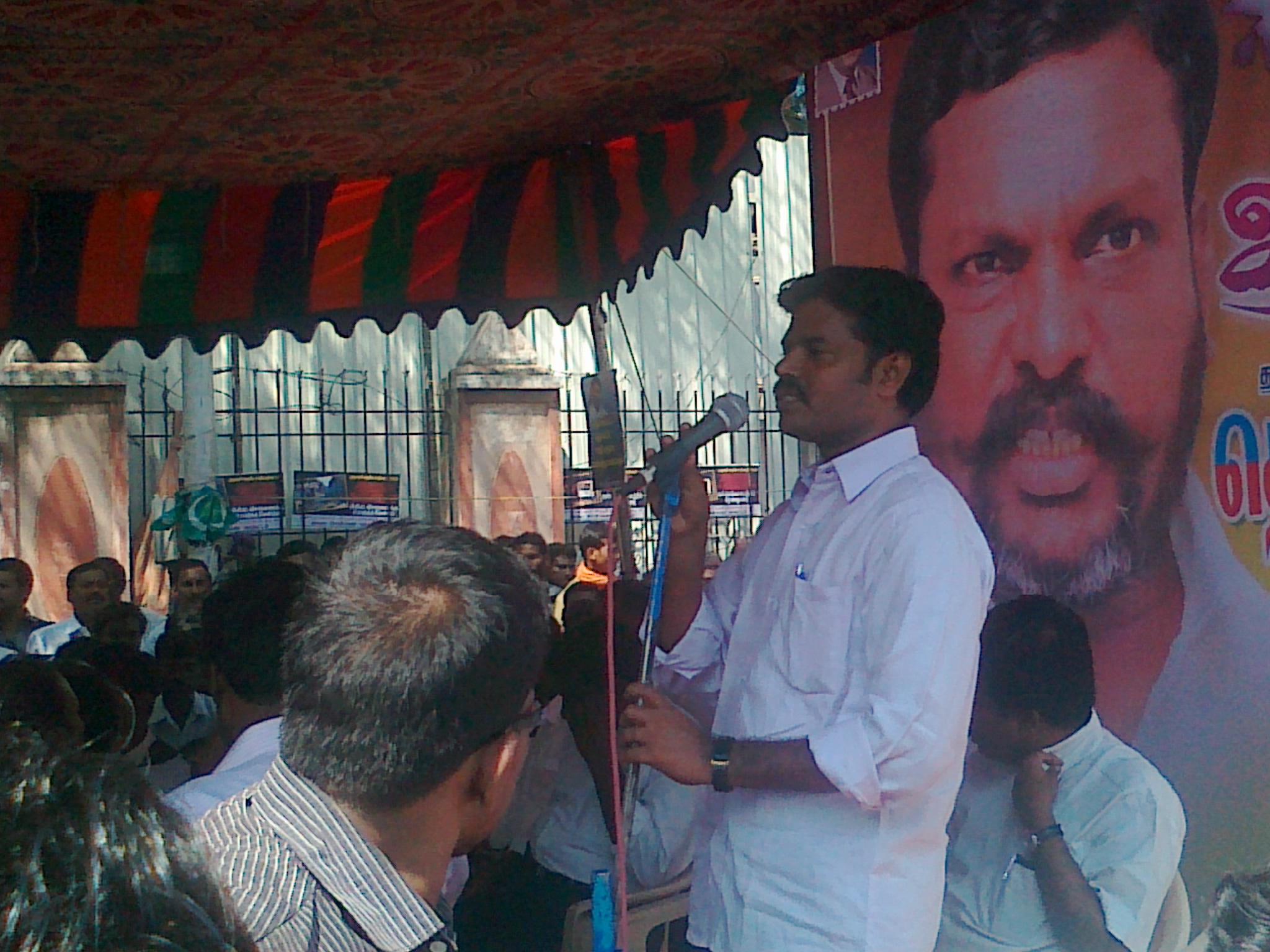 have very little chance of winning so we need the support of non-Dalits. When problems arise, as you say, we get complaints to the party leadership and what they say is that there are clashes occurring here. Even today there was an issue; it came up at the Court yesterday. In Seshasamudram3 there was a dispute between the cheri and oor over pulling the temple car. When the argument arose 44 Dalits were imprisoned, but not a single Vanniyar was arrested or imprisoned. Those creating the problem are the Vanniyars and the victims are the Dalits. When that problem is occurring who is it who takes up the issue? The VCK is the only party to address the issue. Similarly there was a problem in Namakkal4 where they had been without a path to the cremation grounds for 20 years in a place called Munjanoor. There again it was the Viduthalai Chiruthaigal who took up the issue. As soon as the VCK stepped into the breach and took up the issue – the victims there are Arunthathiyars – no-one there made compromises with the non-Dalits. Because we protested without compromise the people have gained an access route to the cremation grounds today. I can keep giving examples like this, but in some villages there are minor or petty confrontations and we also have the responsibility to ensure that we engage in dialogue to prevent these small problems from escalating into major caste clashes. You see the Panthers can make a fuss and then leave the village, but the villagers there need to live in peace. We cannot allow the problems caused by a few to adversely affect the entire village. In those situations we have to resolve matters through dialogue, there is no other option. In those situations one or two frustrated people might come and accuse us of compromise, but in some places such compromises are necessary to protect the people. What do we hold protests for? In search of peace and harmony, that’s why. So in some villages the party has a duty to prevent small issues from escalating and responsibilities to maintain the peace, but some people misunderstand this. That is the situation.
have very little chance of winning so we need the support of non-Dalits. When problems arise, as you say, we get complaints to the party leadership and what they say is that there are clashes occurring here. Even today there was an issue; it came up at the Court yesterday. In Seshasamudram3 there was a dispute between the cheri and oor over pulling the temple car. When the argument arose 44 Dalits were imprisoned, but not a single Vanniyar was arrested or imprisoned. Those creating the problem are the Vanniyars and the victims are the Dalits. When that problem is occurring who is it who takes up the issue? The VCK is the only party to address the issue. Similarly there was a problem in Namakkal4 where they had been without a path to the cremation grounds for 20 years in a place called Munjanoor. There again it was the Viduthalai Chiruthaigal who took up the issue. As soon as the VCK stepped into the breach and took up the issue – the victims there are Arunthathiyars – no-one there made compromises with the non-Dalits. Because we protested without compromise the people have gained an access route to the cremation grounds today. I can keep giving examples like this, but in some villages there are minor or petty confrontations and we also have the responsibility to ensure that we engage in dialogue to prevent these small problems from escalating into major caste clashes. You see the Panthers can make a fuss and then leave the village, but the villagers there need to live in peace. We cannot allow the problems caused by a few to adversely affect the entire village. In those situations we have to resolve matters through dialogue, there is no other option. In those situations one or two frustrated people might come and accuse us of compromise, but in some places such compromises are necessary to protect the people. What do we hold protests for? In search of peace and harmony, that’s why. So in some villages the party has a duty to prevent small issues from escalating and responsibilities to maintain the peace, but some people misunderstand this. That is the situation.
Hugo: That is an important point, but protests are not just to keep the peace [Sannah: No], they are also struggles for justice. If we do not gain justice then what is the point of the struggle? This accusation is also there. For example in Madurai there is Vandiyur Theerthukadu. Despite judgements from the Court, High Court and Supreme Court upper castes continue to occupy the land. Then what the residents there say is that there must be some compromise happening that means that we have yet to reclaim the land.
Sannah: They may say that, but in the place you mention who is supporting the upper castes? Are the Viduthalai Chiruthaigal behind them? [Hugo: No]. No, but the entire machinery of the government gives them support.
Hugo: Sure, but if you protest continuously will you not be able to regain the land?
Sannah: Definitely we would get it, if we protested continuously we would definitely get the land, but at the same time the VCK is not just a full time protest organisation. We protest to protect the people, but at the same time we also protest to gain a foothold in politics. There are many types of protest. This does not mean that we abandon this cause. We are still protesting about this as much as we can. Just yesterday they posted something about the issue on Facebook, about people being forced to carry shoes in their hands. This still happens today.
Hugo: Where was this?
Sannah: In a village near Dindugal. There are such problems in many places, but it is only when we become aware of these issues that everyone realises that the problems exist. There are so many villages which have not come to public attention, what can we say about them? Now we in the VCK need to tackle court cases, protest, lead struggles, stand against caste- Hindus, stand against exploiters, stand against the police, address the concerns and doubts of party comrades, address the concerns of non- Dalits in the party – it is within this multitude of concerns that we have to address any problem. We cannot directly confront any problem, but have to be mindful of all these in finding a solution. In some areas we get an immediate resolution in others – like in Munjanoor (Namakal District) – it took 20 years to get a solution. In those 20 years what will the people have said? They will have said: ‘this lot come and go, and come and go’, that is what they will have said. Today we were successful on the back of continued protests – this was not a one-off demonstration or a problem that arose the other day. Caste is an issue that has been ongoing for thousands of years and you cannot resolve that in two or three days. It takes years of sustained protests. If the VCK back off from such protests then you can condemn us. If they accuse us of selling out even when protests are ongoing then it is our job to help them understand the ground realities.
Hugo: Right, but now you have become a party. Since becoming a party have your ideals and priorities changed?
Sannah: That is, as our leader Thirumavalavan has said, we have changed our tactics but not our principles. The party’s five goals remain the same. The route we take to attain those goals may change with the times. No movement can stick to the same strategy forever – that also would not work out. So there is absolutely no scope to even suggest that we have abandoned or sold out on our underlying ideals since entering electoral politics. Our ideals remain exactly the same and we are continuously protesting towards their realisation.
Hugo: OK, if the ideals are the same has the structure of the party changed? My sense is that the secondary rungs of leaders have not yet attained state level prominence.
Sannah: This is a widespread accusation – that is true – as far as secondary leaders are concerned – whoever the media recognise are the next level leaders. More to the point, the trend in Tamil Nadu is that whoever the leader recognises – they alone are leaders. I’m speaking generally here. He will have been a cinema actor till yesterday, suddenly he will start a party and all the newspapers join as one to elevate him into a major leader. There is no room there for any questions about what he did till that point, what he has protested or spoken about in the past. It is the media that creates leaders. As far as the Viduthalai Chiruthaigal is concerned they focus exclusively on the leader who has been protesting all these years and that is Thiruma.
Hugo: It is not just the media; that is the problem.
Sannah: No, not just the media but I will explain things step by step. The media focus on him and so everyone recognises his face. At the same time within each party there will only be one person who is a mass leader. In every party there is just one mass leader. Second rung leaders need recognition within the party, only then will they gain newspaper and other media recognition. With our party the issue is that because we have emerged from the downtrodden sections everyone has a desire for leadership. This means that there is huge competition for each place. In that sort of competition it is only when each candidate recognises the other that an established secondary leadership can emerge. … If that emerges, then a secondary leadership can emerge. That is one point. Secondly, do people accept those who are already in place assecondary leaders? That is not the case. There is great resistance to accept even those four or five leaders like myself who are known as thinkers across Tamil Nadu. How do we overcome that resistance? We cannot confront it head on, each person has their own views – it is a huge matter that they have accepted Thirumavalavan. They now ask: ‘Should we recognise others and make this party bigger?’ So non-Dalits have prevented the recognition of others. Caught between these two issues, VCK’s secondary leaders are unable to get into the limelight and get stuck where they are.
Hugo: But the party could do more to promote them could it not? [Sannah: True] For example in Vaiko’s party Nanjil Sampath acts as a star speaker.5 There is no such figure in the Panthers apart from Thiruma [Sannah: Yes]. If someone other than Thiruma could be nurtured and allowed to speak in each area then they too would be imprinted in people’s minds.
Sannah: That is true enough, but you cannot say that there are no speakers, they are
Hugo: There is no star speaker though.
Sannah: Even star speakers
Hugo: Not just that, there is the question of what people think about others. For example, in Parali Pudur, where Backward Castes burst into the cheri, set houses alight and beat people up. When I first went there they said: ‘The VCK has done nothing for us’. When I asked further they said: ‘People from the party came and stayed here for over a week and gave us protection and food and so on, but they did not take up the issue properly’. When I asked what that meant they said: ‘No leaders came’. Did no-one come I asked. It turned out that Pandiyammal (VCK’s Madurai Urban District Secretary) had come, Ellalan (VCK’s Madurai Rural District Secretary) had come, ArtralArasu had visited. In the end what it boiled down to was the fact that Thirumavalavan had not been. ArtralArasu is a state leader [Sannah: Yes], Pandiyammal and Ellallan are City and Regional leaders [Sannah: Regional leaders yes]. For the sole reason that Thiruma had not visited they maintained that the VCK had done nothing and have yet to replace the board declaring their allegiance to the party.
Sannah: Yes, people have not yet got the mindset to accept secondary leaders and we need to change that bit by bit. That is a drawback in the party and we have to accept that. The problem is that everyone expects the leader.
Hugo: What I thought was that those three leaders are all local and well-known faces. Had a Ravikumar (General Secretary of VCK and then MLA) or a Sinthanai Selvam (General Secretary of VCK) visited at that time, they would at least have felt that ‘someone has come from the north of the state’ and even though the leader did not go they would have been buoyed by the visit of a big name from elsewhere. [Sannah: Mmm]. You could even do things like this [Sannah: Definitely]. You can send ArtralArasu to Cuddalore and send SinthinaiSelvam to Madurai. In sending them across state like this, the people will gain some belief that the party is taking their concerns seriously in sending big leaders.
Sannah: True, that should have happened but we missed that opportunity. We can change that in the future.
Hugo: OK, one other related question concerns candidates. How do you select them? In 2011 you got 10 seats. Of those 10 there was just the one who was a woman I think. Of the 10 were 2 non-Dalits? [Sannah:Yes]. How do you decide who to give a seat to?
Sannah: In elections when thinking about the candidates, the first point is that whichever party we are allied with determines which seats we will contest from. They decide the constituencies.
Hugo: Do we have no say in that?
Sannah: They determine the place – the seat.
Hugo: Exactly, can we not say that we want these constituencies.
Sannah: Yes, we submit a list. If we hand in a list of 40 then they will give us 10 out of them. That is how it works. Of these there are about five that we can really demand and fight for. But this is decided first by them. When deciding this, the situation that the DMK and ADMK have created is that we should only field local candidates. That is what they think. What that means is: whoever is the majority caste in a constituency will get the position. These two happen, and then the next consideration is whether they have the financial strength to campaign. Candidates are decided on the basis of these three criteria. This is also the procedure for the VCK. We both do and do not follow this line. They only adopt that process to some extent. What we look for within the party when allocating seats is that: they should have some authority amongst the people; they must have worked for the party for a long time; then we consider what their performance in the Assembly would be like – it is on the basis of two or three issues like this that they determine who to nominate. Even if it is the leader who has the final say, he consults widely before doing so. It is on that basis that the leader announces our candidates. This is what has happened in two or three elections. In those announcements then there will assuredly be one woman and one non-Dalit. That has to happen. If we get 10 seats then two non-Dalits and one woman – that is what they set aside. If they have to be Dalit then within Dalits it should be a woman. It is on that basis that in each election one woman would have stood for election in at least one constituency. The same with non-Dalits who could be Muslims or other castes. Seats are set aside for them and it is on that basis that nominations are made. There is nothing massively complicated about all this.
Hugo: Do you think that Thirumavalavan should be a candidate? I’m asking this as Thiruma can hardly ever visit his constituency. He is always on the go, hardly having time to sleep he travels round not just TN but now also to Delhi. This means he cannot conduct his constituency work, so who is looking after that in his absence?
Sannah: Now this question should not even arise … There is a PM in each country, there is a PM in India, does he go to his constituency?
[Hugo: No]. Jayalalitha is there. Does she go to her constituency? Leaders are those who represent people in a political sense. There is always an accusation that their constituencies suffer as a consequence and this exists everywhere. Not just VCK leader Thirumavalavan, but for all leaders. They cannot go to their constituencies. Simple MPs and MLAs can focus on their constituencies, but leaders are unable to do so and that work needs to be taken up by the secondary rung leaders within their parties. On that basis in Chidamambaram MP Constituency the VCK has a huge team to decide what work needs to be done and what needs to happen. That group finds out what places have what issues and draws up a list noting where roads need to be laid, where tanks need to be built, where social centres and libraries are required, where schools are needed, they note all these issues in a list and then allocate funds accordingly from the Rs. 5 Crore constituency funds – they are spending that continuously. That constituency work is happening, it is ongoing – it is not like it is being neglected, but the papers do not report this in any detail. So, as far as leaders are concerned, the questions of can they stand for election or not does not even arise. Party leaders should definitely stand for election because only then will other people gain some faith in him.Hugo: But if that work is not done, then they will not be able to win again – that is the problem.
Sannah: That’s true, that is why I say there is a team working on this. And you also need to please try to understand, that we as a party have an extra limitation. That is, as far as the VCK is concerned, we are not only interested in that MP Constituency or whatever state constituencies we have won, we are involved all over state wherever Dalit and downtrodden people are affected.
Hugo: True, but this raises the question of what have you achieved as a party? What changes have you effected? As a movement you brought about many changes. The promise to return a blow for a blow was etched in people’s minds and created consciousness and mobilisation. What have you done for the people as a party?
Sannah: As I said before, the party can only focus on issues that are raised in society. They reflect society. Back then when we spoke of hitting back, Mukkulathors and Vanniyars were vehemently and violently anti-Dalit. After Dalits started to counter-attack their predatory instincts diminished. Now they do not engage in major riots, they do not tend to set light to cheris, they do not tend to muster people to attack Dalits.6 Though small-scale violence persists in many places, the will to engage in
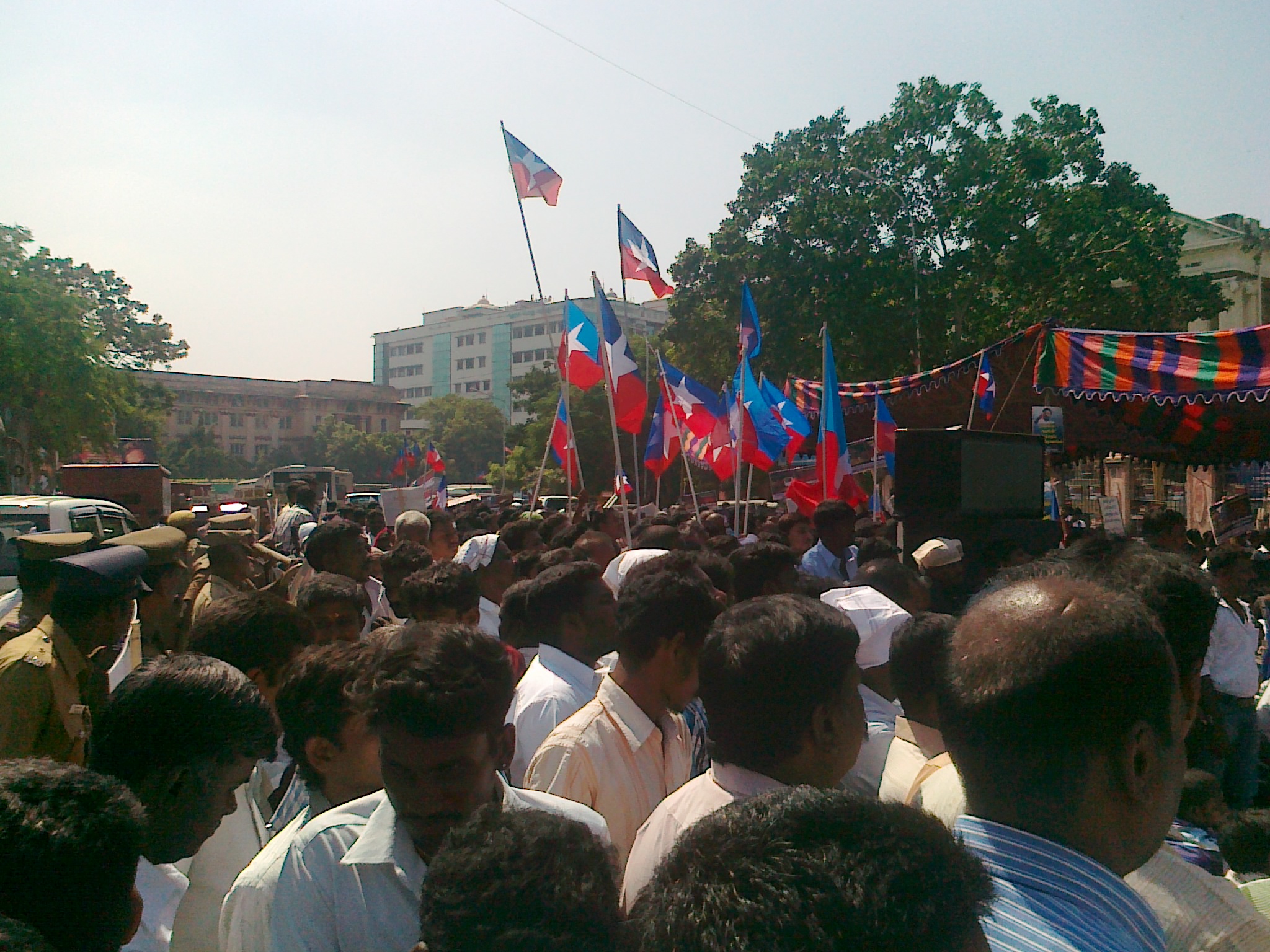 major clashes has declined. Then why should we stick to the same ‘hit back’ slogan and strategy? You can only say that when there is a need. Now, when they are being quiet – after the war, peace is the only way. At a time when they think to be peaceful we too should adopt that path. Even so, wherever there continues to be oppression then the ‘hit back’ slogan will have resonance and will be deployed – that is happening today. We have not abandoned that.
major clashes has declined. Then why should we stick to the same ‘hit back’ slogan and strategy? You can only say that when there is a need. Now, when they are being quiet – after the war, peace is the only way. At a time when they think to be peaceful we too should adopt that path. Even so, wherever there continues to be oppression then the ‘hit back’ slogan will have resonance and will be deployed – that is happening today. We have not abandoned that.
Sannah: Yes, I am coming to that question. When we were a movement the people were mobilised on the basis of emotions to become a political force. As I said before there is a need to channel this political emotion into an organisation and materialise it. If we want to gain political power then we have to become a political party. One cannot take political power as a movement. Till now we had a lot of freedom. We could oppose who we wanted, condemn who we wanted and depended on noone who we might criticise. We condemned anyone we wanted on the basis of our principles. Having become a party, however, we must abide by the norms set down by the Indian Electoral Commission and abide by their regulations. This imposes a certain discipline and we need to be disciplined about who we condemn and how we do so. We need to work within these limits and familiarise ourselves with the political culture. Till now Dalits have been shut out of that, but that has started to develop in the past ten years. Having joined the electoral path we have nurtured this political culture.Hugo: Ok, but as a party what changes have you brought about?
Hugo: Ok, but the voters on the ground are not looking for that. They anticipate job opportunities, houses, freebie policies/handouts – these are what they expect. As a party – furthermore, when you were in the ruling party coalition – could you offer people such opportunities?
Sannah: When we were in the ruling party alliance we were only able to do that to a limited extent, because as far as the VCK was concerned this was the first ever time for us to be in the ruling coalition. It was new and so we were uncertain about how to best use the ruling party. Not knowing, we protested and fought to get the necessary work done, but I am not sure that we were totally successful in this as both the DMK and ADMK have been in government for 50 years and grown accustomed to government. Extracting resources from them and taking them to the people was a serious undertaking and we did not fully succeed in doing so. This is for the future. We need to learn how to do this, we too are still learning aren’t we? We have created an understanding of the processes to some extent though, we have understood how to best use the ruling party.
Hugo: In many places you have also got work for people.
Sannah: We have, that has happened. In many places it has happened. We can’t talk in terms of thousands of opportunities, but certainly in hundreds.
Hugo: Now what you said at the outset was that yours was an ideologically inspired party. If you ask what ideals you have then there are women’s rights, land rights, class equality, and caste eradication. What have you done to realise these?
Sannah: Our five main goals?
Hugo: Yes, now what seems to happen is that there is a clash or a riot today and you rush to the scene and work on that issue. This happens on the one hand. On the other hand you have these ideals. What work are you doing to achieve them?
Sannah: Now you have to understand one point: Dalit politics has an agenda and a goal, but we cannot dedicate ourselves 100% to moving this goal forward 100% of the time. We have the desire to attain them; we make efforts to attain them; we have plans and policies to reach them but as we proceed towards these goals what happens is that they say: if they achieve this the movement will become too big. Not just for the Panthers I am talking about the fate of Dalit movements across India. What the ruling class think is that if we achieve our goals there will be a major change in society. As a consequence they create distractions and diversions; they register cases against party cadre, they instigate riots, once the media and other organisations instigate such conflict then our concentration on the goal is dissipated. Once that happens we end up facing in multiple directions. Then we resolve issues and get back on track only for this to recur again. Whatever the end goal or peak of Dalit politics is, when we are mired in problems time and again we are dragged down and have to wade through these first. An issue that should be resolved in 10 years takes thirty. This is what is happening with the Viduthalai Chiruthaigal, they too cannot escape this fate. Even if the Viduthalai 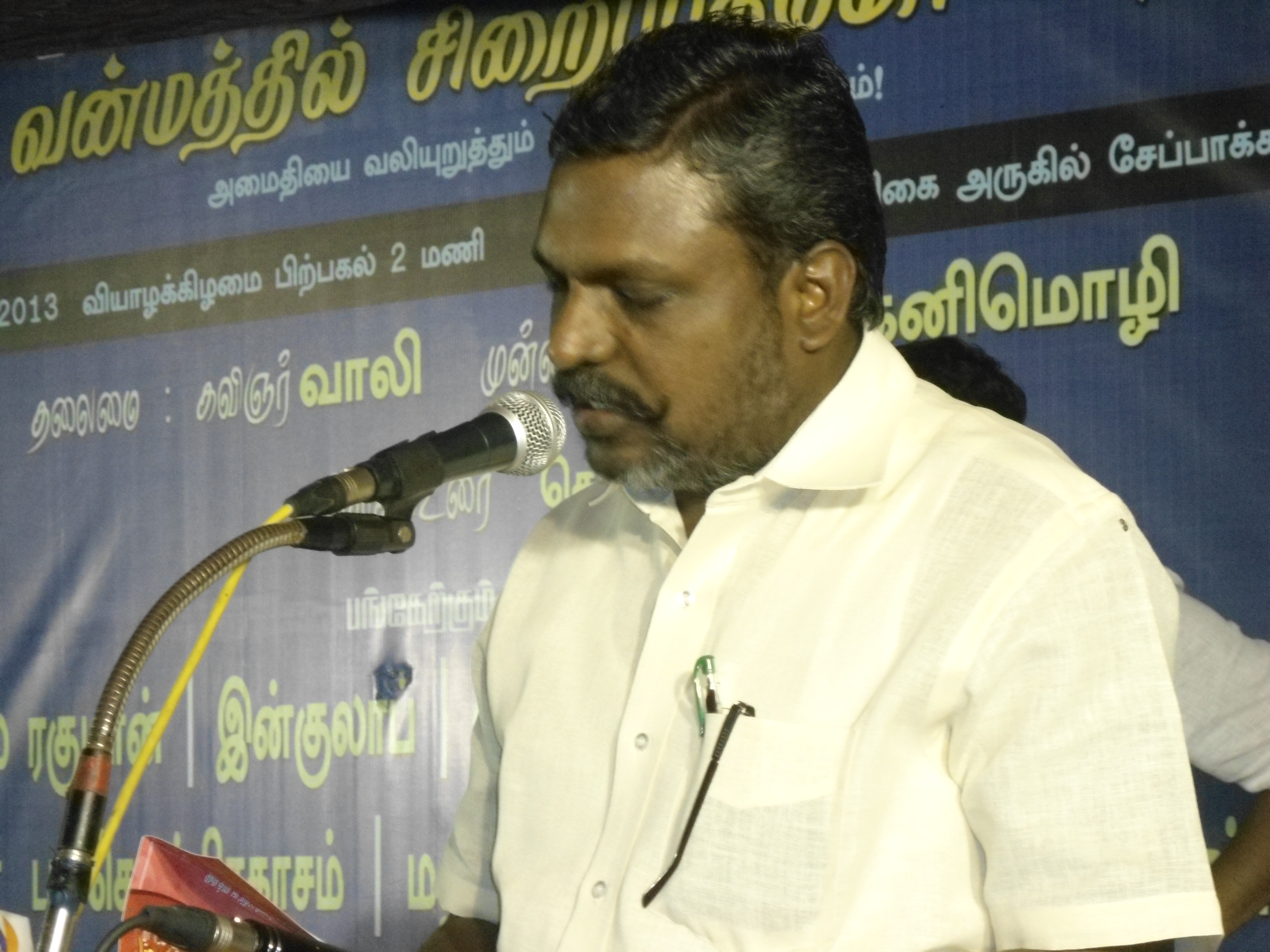 Chiruthaigal stay true to an issue – you yourself mentioned Parali Puthur, here there is Seshasamudram and there are countless villages like this – as we proceed towards our ideals we also have to give attention to them. We have never said that problems will be resolved immediately, but we remain committed to trying to resolve them. This is one point. The next is that the party speaks radically about Tamil Nationalism. Whilst doing so then we work together with parties and non-political organisations that are also campaigning on similar issues. We are working with social organisations and Tamil nationalist outfits for whom elections have no rewards because they are firm in their boycott of elections. We work together on an issue-basis to raise the profile of the cause. We also take up the class struggle. When tackling class inequalities even if we accept that the downtrodden people fall within a class, the intermediate castes do not agree with this analysis. Despite this we do not see the intermediate castes as opponents; we see them as working towards similar ends and join with them in protests. When fighting against exploitation we join with Tamil nationalist movements and with intermediate caste groups as well as with other democratic forces. In terms of women’s rights, these movements speak of women’s rights and we join forces with them on those issues too. Then there is caste eradication. When it comes to caste eradication, however, none of the other parties have this as an objective. The VCK alone has this goal. As far as this ideal is concerned the Viduthalai Chiruthaigal must operate alone and we have no friends whatsoever. They have no need to eradicate caste and they have their own separate agenda. So when you look at our five main ideals, we work with other parties and movements to achieve four of them but we are still in a situation where we have to stand alone and protest for the final issue. We do not believe for a moment that we can resolve all these issues immediately, but we are unerringly working towards those goals. Moreover we have taken these five demands down to the grassroots. No one in the cheris knew about Tamil nationalism; none knew about women’s rights; none knew about campaigns against oppression. If, today, these are matters that are discussed within the cheris then that is a result of the VCK’s efforts alone.
Chiruthaigal stay true to an issue – you yourself mentioned Parali Puthur, here there is Seshasamudram and there are countless villages like this – as we proceed towards our ideals we also have to give attention to them. We have never said that problems will be resolved immediately, but we remain committed to trying to resolve them. This is one point. The next is that the party speaks radically about Tamil Nationalism. Whilst doing so then we work together with parties and non-political organisations that are also campaigning on similar issues. We are working with social organisations and Tamil nationalist outfits for whom elections have no rewards because they are firm in their boycott of elections. We work together on an issue-basis to raise the profile of the cause. We also take up the class struggle. When tackling class inequalities even if we accept that the downtrodden people fall within a class, the intermediate castes do not agree with this analysis. Despite this we do not see the intermediate castes as opponents; we see them as working towards similar ends and join with them in protests. When fighting against exploitation we join with Tamil nationalist movements and with intermediate caste groups as well as with other democratic forces. In terms of women’s rights, these movements speak of women’s rights and we join forces with them on those issues too. Then there is caste eradication. When it comes to caste eradication, however, none of the other parties have this as an objective. The VCK alone has this goal. As far as this ideal is concerned the Viduthalai Chiruthaigal must operate alone and we have no friends whatsoever. They have no need to eradicate caste and they have their own separate agenda. So when you look at our five main ideals, we work with other parties and movements to achieve four of them but we are still in a situation where we have to stand alone and protest for the final issue. We do not believe for a moment that we can resolve all these issues immediately, but we are unerringly working towards those goals. Moreover we have taken these five demands down to the grassroots. No one in the cheris knew about Tamil nationalism; none knew about women’s rights; none knew about campaigns against oppression. If, today, these are matters that are discussed within the cheris then that is a result of the VCK’s efforts alone.
Hugo: They may speak about them, but if you take caste eradication this has yet to take root at the ground level. This is why between Pallars, Paraiayars and Arunthathiyars …
Sannah: Problems arise – that is true.
Hugo: There is no unity amongst them, no inter-marriages. Where they do marry; their families do not accept them, so how do we take these ideals to the people?
Sannah: This is what I have been saying. Now take the demand to eradicate caste: the VCK is just 22 years old. That too, we have been in party politics for about 12 years. How can you possibly expect us to resolve a 2000 year old problem in 12 years? We have created a platform haven’t we? The fact that Arunthathiyars, Pallars and other castes are now joining the party is something that we could never have anticipated before isn’t it? A party can only create that platform and you cannot condemn us on this basis alone.
Hugo: I totally accept that, but what are the next steps? That is my question. What steps are you taking towards these goals? You will have discussed this in the party and talked about how to progress.
Sannah: Now, up to the present what we have had is the leader meeting directly with the people and holding demonstrations, now technology has advanced. Now with the advance of technology there is a huge question mark over whether we can reach the grassroots without harnessing it because all existing media – if I go and speak in a village I could speak for one hour. After I have finished speaking and left they will spend 10 hours watching television. Other concepts and ideas are taken to them via the television, so the issues that I spoke about will be forgotten within the hour. Only if that message is taken to them continuously will their doubts and thoughts start to change. Only then will the ideas of caste eradication and women’s liberation begin to imprint themselves in people’s minds. While people are publicising the goals of the movement the next stage for the Panthers must be to take the media into their hands and take these issues to the viewers. If we can compete with other channels then we believe that we can turn the media into a democratic force. At present we are in the process of trying to take the media into our hands.
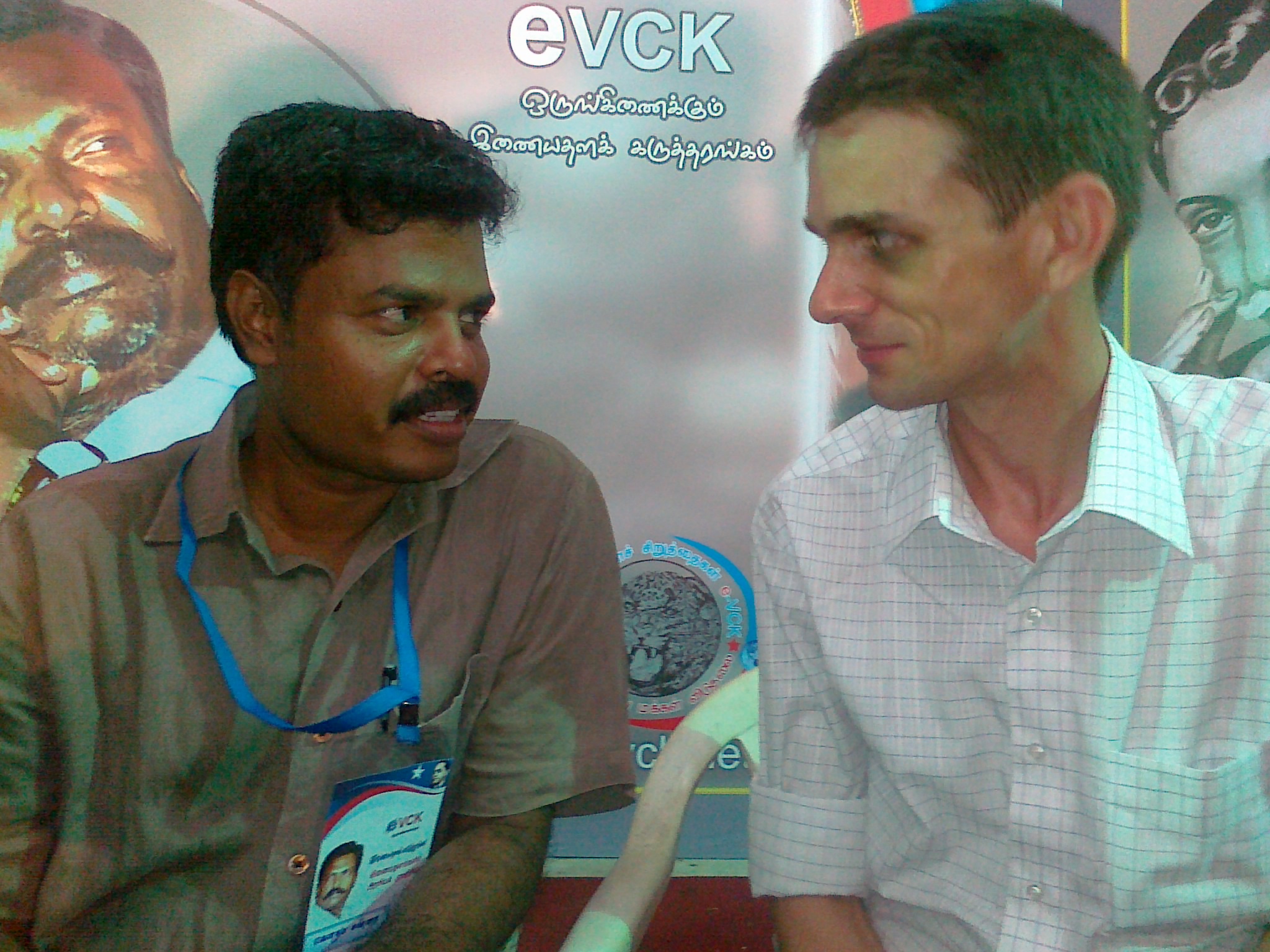 Hugo: OK. On a different matter – two months ago I was in Karnataka where I met M.C. Raj of REDS who is leading a campaign on proportional representation. They see the electoral system as flawed. Are you taking part in these discussions?
Hugo: OK. On a different matter – two months ago I was in Karnataka where I met M.C. Raj of REDS who is leading a campaign on proportional representation. They see the electoral system as flawed. Are you taking part in these discussions?
Sannah: Definitely, definitely. Now in Sri Lanka, the Sri Lankan government is extremely oppressive, but at the same time there is the necessary representation for Tamils. Even if Rajapaksa’s government wins with an overall majority, there is the opportunity for opposition MPs to enter parliament and it is their proportionate electoral system that is the reason for this. Here we do not have that. He it is numbers alone. It is a majoritarian electoral system. There is a vote. If there are 100 votes then whoever gets 51 votes is the winner, but I will give you a small example. Let us assume there are 100 votes. 3 or 4 parties compete together in a coalition. In terms of voter turnout we have yet to cross 70% in India. In general it is 68 or 65% that is all. Then that means that 30% of the people do not vote in elections. Of the remaining 70%, the ruling party gets some, the opposition party some and the third parties pick up votes as well. All in all at the end of the day when we add up how many votes the ruling party has received it is between 25 and 30% of the vote. What this means is that in truth the government in India is a minority government. Even if they gain 30-40% of the vote that means that 60% of the voters are against them. Then how can we call this a democratic country? So we oppose this voting system. If MPs and MLAs were distributed on the number of votes each party receives then everyone would get the opportunity to enter parliament. Therefore we wholeheartedly support the campaign for proportionate electorates and are thinking of launching a campaign on this issue. Although we have taken part in existing campaigns we are considering launching our own dedicated mass movement on the issue.
Hugo: This is important, because if this occurred then there would be no need to rely on coalitions.
Sannah: Exactly, there would be no necessity of that at all.
Hugo: I have taken a lot of your time and learned many issues from you. Many thanks.
——————————————
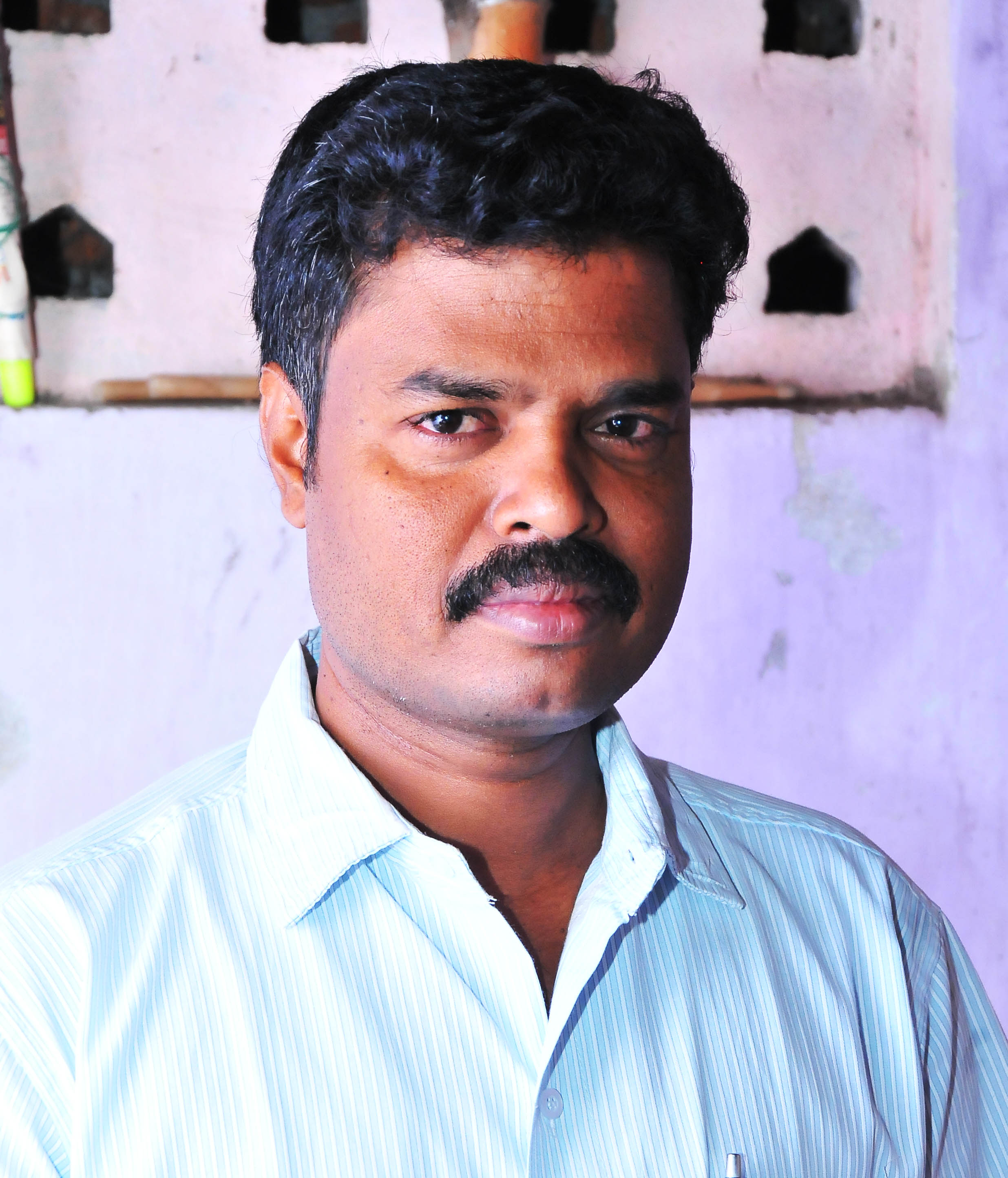 J.Gowthama Sannah: (39), M.A. (History), M.L is a writer and ideologue of Dalit politics and sociology. He has published over 80 articles in several Tamil magazines since 1995. He has also written several books on Dalit and social issues: // 1. Anti-Conversion Act – history, socio-political background and its impact published by Marutha Publication (2006). // 2. Ayothidass Pandithar, A brief monograph in Tamil, published by Sahitya Academy, a unit of Social and Cultural Ministry, Govt of India (2007) / 3. Pandithari Kodai (Gift of Pandithar Ayothidass) – on the leader who gave the Reservation concept to modern India from the south. Published by Kalkam Publications (2007) // 4. Edited the ‘Liberation of Menfolk’, an address delivered by Meenambal in 1930 at Tirunelveli. She was the first women leader in South India. Published by Krisal Pathipagam (2009). // 5. Compiler and publisher of Tamil Uyir (Tamil Life, 2009) a collection of eminent artists’ paintings based on the suffering of the Sri Lankan Tamils. Forthcoming books // 1. Kalakathin Maraiporul – a collection of articles’ which have been published in various journals. 2. Tamilan Ozitha Sathi – (Tamilan who destroyed caste) //3. Mathavilasa Kandanam (A refutation of Matha Vilasa Prahanasam (the humour of the insane) which was written by King Mahenra Varma Pallavan, 630AD // 4. Kurathiaru – fiction; a mythical history and magical realistic account of the river Kotralai. // As well as writing about caste and politics in Tamil Nadu, Sannah has been heavily involved in campaigning both before and since joining the VCK. His activities include: // 1. Founder, SANGAM – a Dalit and Buddhist archive and a platform for propagating Ambedkar’s thoughts (1996) // 2. Founder, Dalit Student Federation- for uniting Dalit students all over the state. (1999) //3. Founder member of AKMK – All Colleges Student Federation (1999) // 4. Founder member and Treasurer of SIDWA – South Indian Dalit Writers Association (2003) // 5. One of the founder members of International Institute of Dalit Studies, Chennai (2004) // 6. Founder, Young Buddhist Association (YBA) (2005) // 7. Founder Member, Creators for Social Harmony (2012) – a coalition of writers, poets, artists and play-wrights who came together in the aftermath of the violence in Dharmapuri.
J.Gowthama Sannah: (39), M.A. (History), M.L is a writer and ideologue of Dalit politics and sociology. He has published over 80 articles in several Tamil magazines since 1995. He has also written several books on Dalit and social issues: // 1. Anti-Conversion Act – history, socio-political background and its impact published by Marutha Publication (2006). // 2. Ayothidass Pandithar, A brief monograph in Tamil, published by Sahitya Academy, a unit of Social and Cultural Ministry, Govt of India (2007) / 3. Pandithari Kodai (Gift of Pandithar Ayothidass) – on the leader who gave the Reservation concept to modern India from the south. Published by Kalkam Publications (2007) // 4. Edited the ‘Liberation of Menfolk’, an address delivered by Meenambal in 1930 at Tirunelveli. She was the first women leader in South India. Published by Krisal Pathipagam (2009). // 5. Compiler and publisher of Tamil Uyir (Tamil Life, 2009) a collection of eminent artists’ paintings based on the suffering of the Sri Lankan Tamils. Forthcoming books // 1. Kalakathin Maraiporul – a collection of articles’ which have been published in various journals. 2. Tamilan Ozitha Sathi – (Tamilan who destroyed caste) //3. Mathavilasa Kandanam (A refutation of Matha Vilasa Prahanasam (the humour of the insane) which was written by King Mahenra Varma Pallavan, 630AD // 4. Kurathiaru – fiction; a mythical history and magical realistic account of the river Kotralai. // As well as writing about caste and politics in Tamil Nadu, Sannah has been heavily involved in campaigning both before and since joining the VCK. His activities include: // 1. Founder, SANGAM – a Dalit and Buddhist archive and a platform for propagating Ambedkar’s thoughts (1996) // 2. Founder, Dalit Student Federation- for uniting Dalit students all over the state. (1999) //3. Founder member of AKMK – All Colleges Student Federation (1999) // 4. Founder member and Treasurer of SIDWA – South Indian Dalit Writers Association (2003) // 5. One of the founder members of International Institute of Dalit Studies, Chennai (2004) // 6. Founder, Young Buddhist Association (YBA) (2005) // 7. Founder Member, Creators for Social Harmony (2012) – a coalition of writers, poets, artists and play-wrights who came together in the aftermath of the violence in Dharmapuri.
————————-
http://journals.ed.ac.uk/southasianist/article/view/146/84
http://journals.ed.ac.uk/southasianist/article/view/147/87
http://journals.ed.ac.uk/southasianist/article/view/147

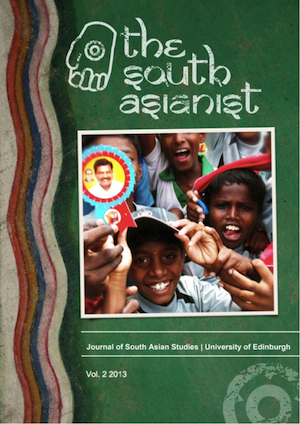
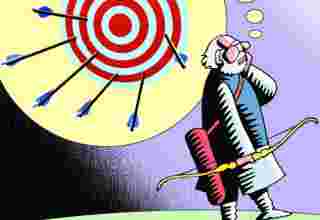
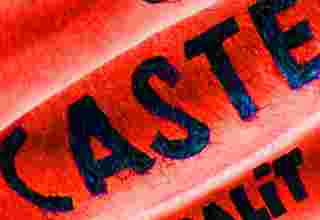
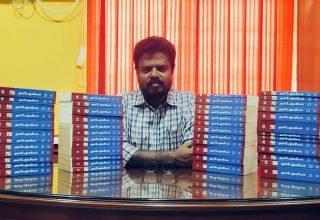
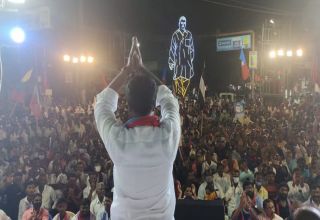
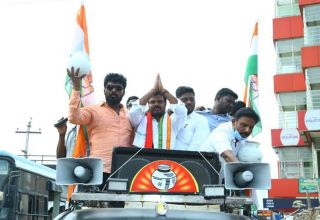
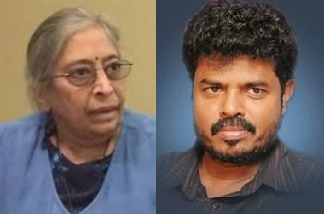





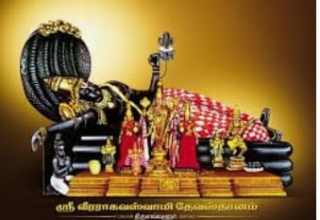
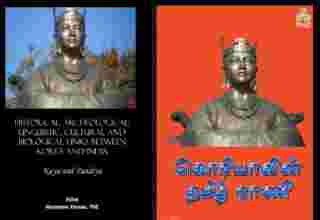
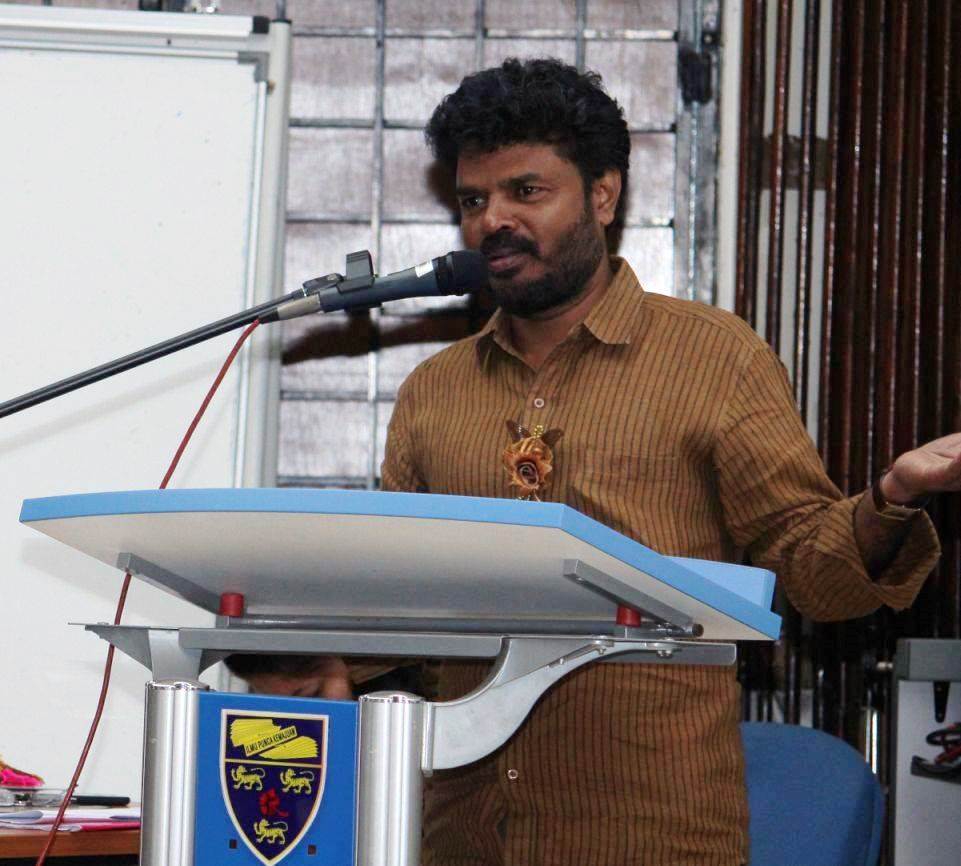


Kumaresan Asak
May 19, 2013 at 7:39 am
அன்புத் தோழருக்கு,
வணக்கம்.
உங்கள் விரிவான பேட்டியைப் படித்தேன். பொதுவாக உங்களது பல கருத்துகளோடு உடன்படுகிறேன். ஆய்வு மனப்பான்மையுடன் தகவல்களைத் தொகுத்தும், உரிய வரிசையில் வெளிச்சப்படுத்தியும் தலித் விடுதலைக்கும் சமத்துவத்திற்குமான லட்சியத்தோடு இணைத்துக் கூறியிருக்கிறீர்கள்.
கம்யூனிஸ்ட்டுகள் பற்றிய கேள்விக்கான பதிலில், அவர்களது வரலாற்றுத் தவறு பற்றிய விமர்சனம் மட்டுமே மேலோங்கியிருக்கிறது. அவர்களுடைய நேர்மையான நோக்கம், தியாகம் செரிந்த பங்களிப்பு ஆகியவை குறித்த சிறிதளவு அங்கீகாரம் கூட இல்லை. தருமபுரி, அதற்கு முன் உத்தப்புரம், அதற்கு முன் வெண்மணி என பல பகுதிகளில் எங்களது அக்கறை மிகுந்த தலையீடுகளையும் பணிகளையும் அங்கீகரிக்கத் தயங்குவது ஏன்? இனி வரும் காலத்திலும் கம்யூனிஸ்ட்டுகளை ஒதுக்கிவிட்டே இயக்கத்தைத் தொடரலாம் என்ற கணக்கீடாக இதை எடுத்துக்கொள்ளலாமா?
தலித் மக்களிடையே உள்ள சாதிப்பிரிவு உணர்வுகளை கம்யூனிஸ்ட்டுகளும் கிளறிவிட்டார்கள் என்ற கேள்வியை ஹியூகோ உள்நோக்கத்துடன் கேட்டிருக்கிறார். நீங்களும் கூசாமல் ஆம் என்று பதிலளித்திருக்கிறீர்கள். இதன் அர்த்தம் ஒட்டுமொத்த தலித் விடுதலை நிலைபெற்றபின் உள் ஏற்றத்தாழ்வுகளைத் தீர்த்துக்கொள்ளலாம் என்பதா? அதுவரையில் இந்த உள் வேற்றுமைகள் இருந்துவிட்டுப் போகட்டும் என்பதா?
அப்படித்தான் என்றால், வர்க்கப்போராட்டம் நடந்தால் சாதிப்பிரச்சனையும் தீர்ந்துவிடும் என்று அன்றைய கம்யூனிஸ்ட்டுகள் மேலோட்டமான புரிதலுடன் கூறியதற்கும் இதற்கும் வேறுபாடு என்ன?
இன்று மார்க்சிஸ்ட் கட்சி, வர்க்கப் போராட்டம் இந்த மண்ணின் தலித் போராட்டத்திலிருந்து பிரிக்க முடியாதது, இரண்டும் சம காலத்தில் மேற்கொள்ளப்பட வேண்டியது என்ற புரிதலுடன் செயல்படுகிறார்கள். அதே போல், தலித் மக்களுக்குள் உள்ள பிரிவுகளிடையே வரும் பிரச்சனைகளிலும் தலையிடுகிறார்கள்.
தமிழகத்தில் தலித் போராட்ட எழுச்சியின் அடையாளமாக திருமா உருவாகியிருப்பதை நான் முழுமையாக ஏற்கிறேன். அதே வேளையில் தனிமனித வழிபாட்டுத்தனம் இருப்பதையும், நிகழ்ச்சிகளில் திரட்டப்படுகிற தலித் இளைஞர்கள் (உங்களைப் போன்ற அறிவுத்தளத்தில் செயல்படுகிற சில தோழர்களைத் தவிர்த்து) “எழுச்சித் தமிழர்” என்ற சொல்லைக் கேட்டவுடன் உணர்ச்சிவசப்பட்டு கைதட்டி, விசிலடிக்கிறவர்களாக வைக்கப்பட்டிருக்கிறார்களே என்ற விமர்சனம் எனக்கு உண்டு. இயக்கத்தைக் கட்டுவதற்கு இது தேவைப்படுகிறது என்று சொல்லி ஒதுக்கிவிடுவீர்களா?
இங்கு நடைபெற வேண்டிய சமத்துவ சமுதாயத்திற்கான நெடும்போராட்டத்திற்கான திட்டத்தின் பல்வேறு கட்டங்கள் பற்றிய எங்களது வியூகத்தை எங்களது கட்சித் திட்டத்தில் வரையறுத்துக் கூறியிருக்கிறோம். தேவையெனில் உங்களுக்குத் தருகிறேன். படித்துப்பாருங்கள்.
மாற்றத்திற்கான போராட்டம் வெற்றி பெறும். அது கம்யூனிஸ்ட்டுகளால் மட்டும் நிகழப்போவதில்லை என்ற தெளிவு எம்மிடம் இருக்கிறது தோழரே.
தொடர்ந்து நாம் விவாதிப்போம். வாய்ப்பிருப்பின் சில சந்திப்புகளுக்கு ஏற்பாடு செய்யுங்கள்.
புரட்சிகர வாழ்த்துகள்.
-அ. குமரேசன்
கதைக்களம்
May 19, 2013 at 8:32 pm
வாழ்த்துக்கள்.பேட்டி அருமை.விவாதப்பொருளாகியுள்ள அனைத்தையும் விரிவாக ஆய்ந்து ஆவன செய்ய வேண்டும்.
ஓவியர் மு.ஈழவளவன் -புதுச்சேரி .
December 18, 2013 at 5:18 pm
தோழர் கௌதம சன்னா அவர்களின் எழுத்துக்கள் இந்துக்களின் பொய்யான வரலாற்றை தவுடு பொடியாக்கி, மெய்யான பௌத்த வரலாற்றை மெய்பித்து வருகின்றன …மிகவும் பயனான வரலாற்று உண்மைகளை உலகுக்கு சொல்ல வேண்டிய கடமை அவருக்கு உண்டு
வாழ்த்துக்கள் ……..தோழர் …….
M Krishnan,National General Secretary ,SAIL SC/ST Employees Federation.
February 10, 2014 at 2:00 pm
The interview is very good supported with facts and figures and relevant events
in the history. The question is where we are heading into ,for the liberation of dalits
form the clutches of castiest and anti dalit communites. The intellectuals should work on it
to set an agenda and direction for faster remedy. The short time political gains/political alliances may vanish one leader after another.. The established leaders like thiruma, ramdas athwale, Ramvilas paswan, mayavathi like wise all the leaders should meet and set the agenda. Working in isolation may weaken our national movements..It is time we wake up to realise the dreams by Dr.BR and Ayothidass pandithar.
M Krishnan
National General Secretary
SAIL SC/ST Employees Federation
New Delhi/Salem.
gowthama sannah
August 31, 2015 at 10:45 pm
I have accepted the views on my interview that what is mentioned, and there is some huge problem to cultivate unity between Ramdass and Thiruma. As Dr.Ramadass is a caste venom in the contemporary. Hence you are requested to rethink..
sanna